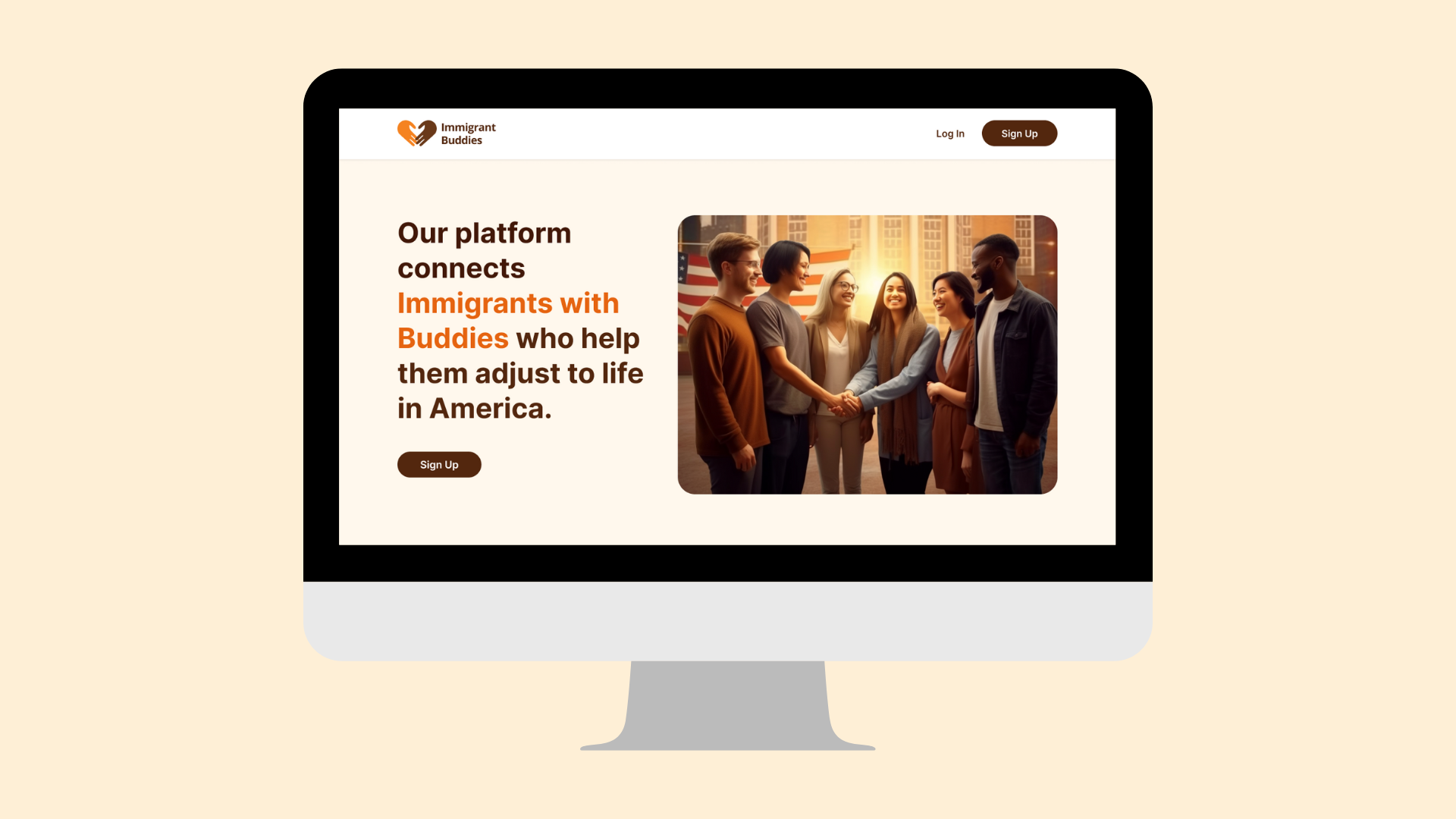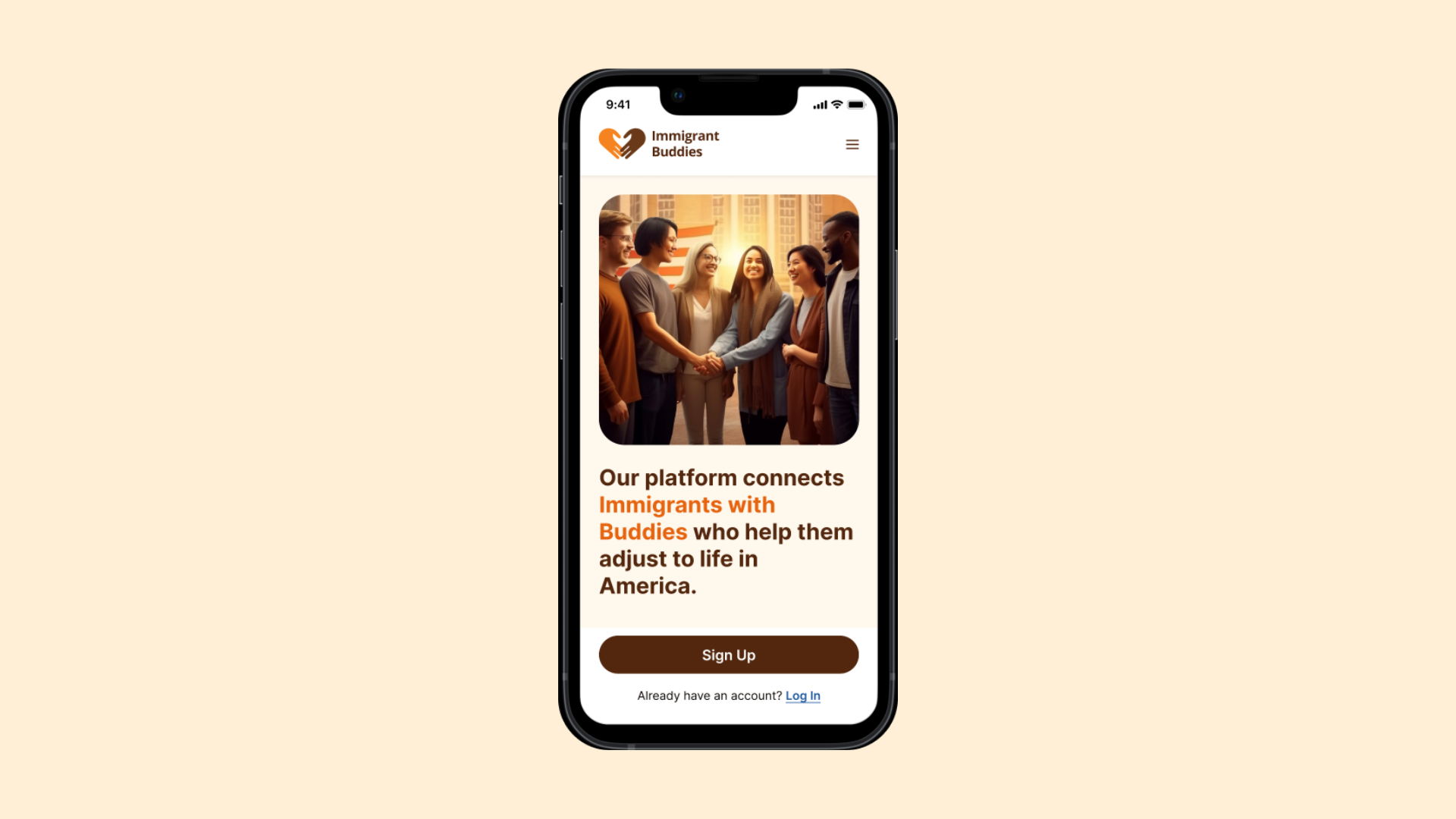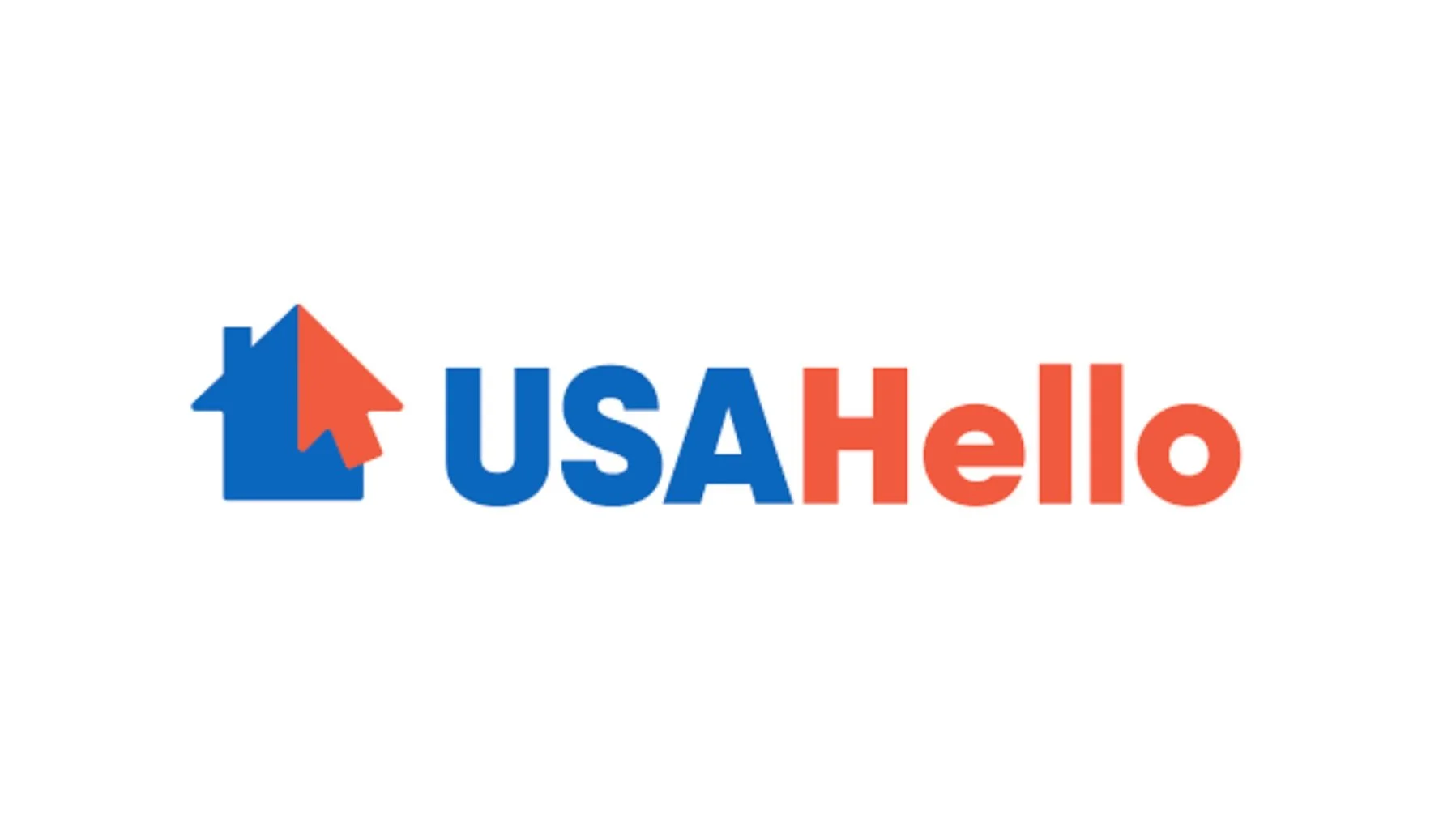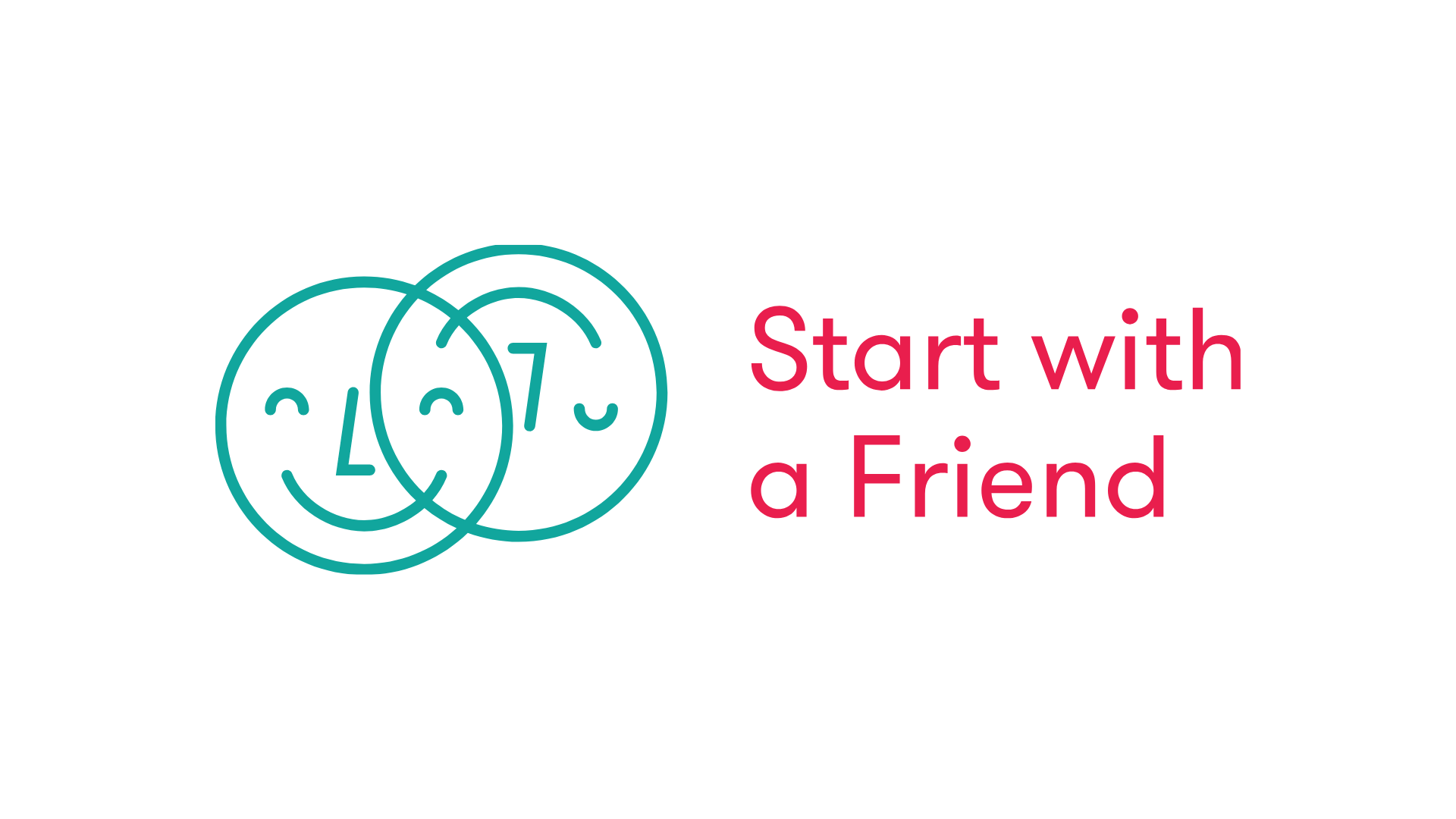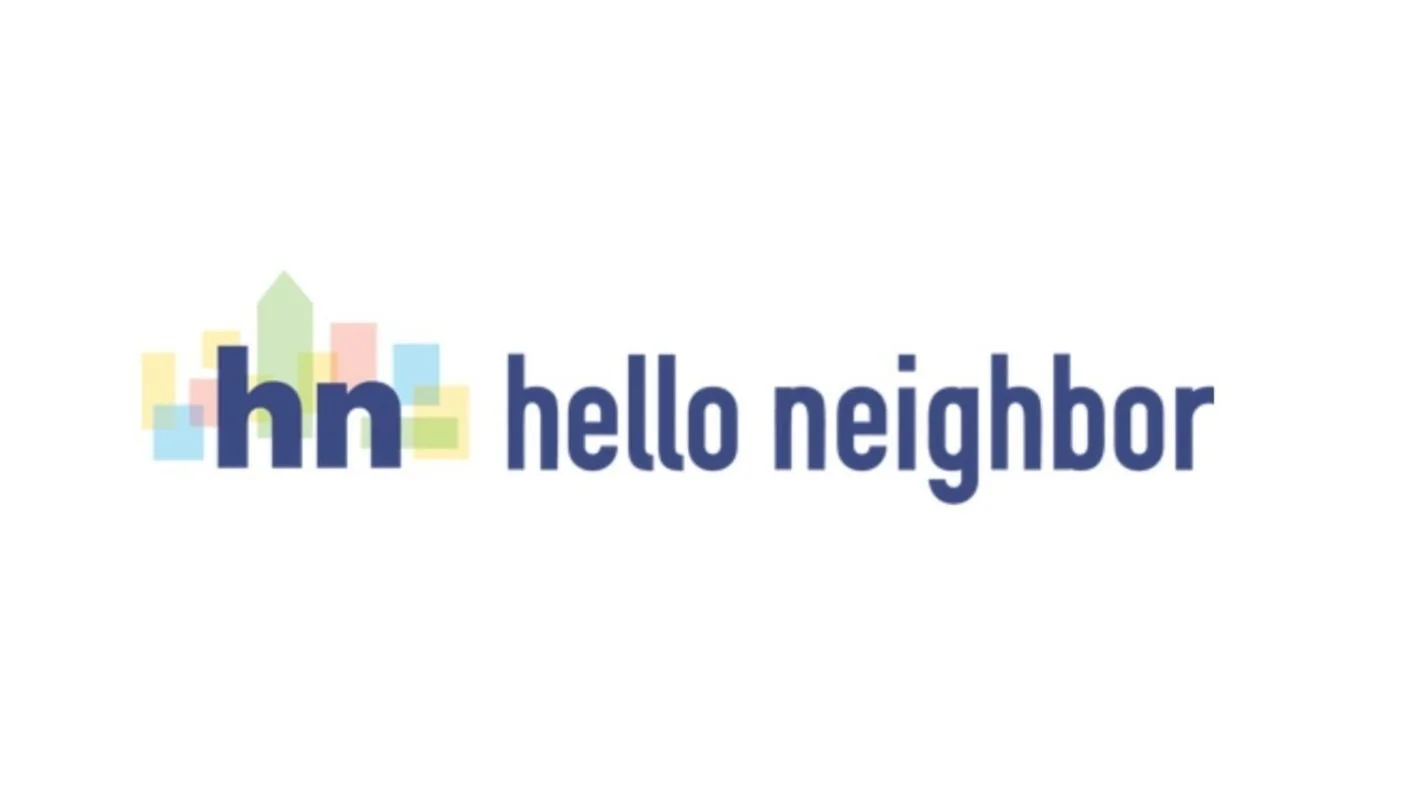Immigrant Buddies connects new immigrants with Buddies (mentors and friends) who help them adjust to life in America

Project Overview
Company
Immigrant Buddies is my social impact organization. Our mission is to help immigrants integrate into America, creating a diverse, inclusive, and prosperous society. I developed our concept idea from a th.0 Hackathon, where I created our predecessor Refugee Buddies. I decided to tailor the concept to American immigrants, drawing on my experiences as a childhood immigrant.
My Role
As the Founder, I manage all aspects of the organization. I recruited volunteer team members, immigrants, and Buddies. My most relevant role is as a Head of Design managing a team of 4 UX Designers. I create and project manage our design process, holding weekly meetings and delegating tasks. I also do hands-on UX work and support the team by giving guidance and feedback.
Market Opportunity
At the time of project inception, there were 1.6 million immigrants in the diverse city of Houston, where I aim to first launch, and 45 million in America, where we will expand. The immigrant population is rapidly increasing, with 2 million new entrants per year from 2021-2023, and is projected to grow by 9-16% each decade from 2015-2065. Thus, there was projected to be an influx of people to serve.
Timeline
September 2023- Present
Problem
Once new immigrants arrive in America, they are faced with the challenge of starting a new life. Our problem to solve is immigrant integration, which means “the process by which immigrants come to feel and become participants in life in America, and in its schools, workplaces, and communities” (Migration Policy Institute). We asked, “How might we make this transition smoother and faster?”
Skills & Tools
User Interviews, Competitive Analysis, Comparative Analysis, Synthesis, Information Architecture, User Flows, Site Maps, Personas, Ideation, Sketching, Wireframing, Interaction Design, Design Systems, Visual Design, Prototyping, Usability Testing, Figma, Figjam, Jira, Google Suite
Solution
Our solution is a peer-to-peer web support platform to connect new immigrants with Buddies. Buddies will be local Americans who contribute their time, friendship, and mentorship to help immigrants integrate. Anyone can sign up to be a Buddy, including native-born Americans and immigrants who have been in America for a while and underwent the transition process.
Goal & Outcome
Once launched, the goal of our product is for immigrant users to make supportive connections with Buddies who help them adjust to life in America and fulfill their goals of why they came here. On the other end, Buddies will also gain cultural awareness and empathy for the immigrant experience. We will measure this with surveys of the mentorships that are formed from the platform.
Watch these final prototype videos to view our upcoming web platform.
In these videos, I walk through the user flow and functionality of our prototype. After viewing the videos, you can scroll through the details of our design process.
Desktop
Mobile Web
Process Overview
1. Discover
Idea conception- Refugee Buddies
Internet research for background knowledge of immigrant needs, paths to citizenship, and immigrant types/ VISAs
Market Research of immigrant and Buddy populations (TAM/SAM/SOM)
32 immigrant surveys
Competitive Analysis: Immigrant Services
5 immigrant user interviews
Determination of common Areas of Help for immigrants and their order of importance
2. Define
Affinity Mapping
Immigrant personas (of each type)
Buddy persona
User Journey Mapping
Problem Statement
Comparative Analysis: UX filter/sorting capabilities design
Definition of new features in addition to original prototype (connect request/accept system, My Buddies, Contact Us)
3. Design
Usability tests of the previous Refugee Buddies mobile app, to inform our new responsive website design
Solution statement
Preliminary website for Concierge MVP concept test
Feedback & validation from MVP
User flows
Sitemaps
Sketches
Low-fi mobile prototype v1
Usability tests
Design system
4. Deliver
High-fi mobile prototype v2
Usability tests
High-fi mobile prototype v3
High-fi desktop prototype v1
Usability tests
High-fi desktop prototype v2
High-fi tablet prototypes
Handoff to development
Ongoing design adjustments
Final screens
Additional Feature definition from MVP program (multi-language, verification/ review process, resources section)
Current Development
Launch in Summer 2025
Discover
The idea of Immigrant Buddies originated from Refugee Buddies, a mobile app concept I created at a TH.0 Hackathon.
At the 2022 Hackathon, the prompt was to find a solution for Ukrainian refugees to adjust to life (integrate) in neighboring countries like Poland. I conceived the concept of Refugee Buddies, a mobile app that connects Ukrainian refugees with local Buddies (mentors and friends) in their host countries. View the case study for Refugee Buddies here.
In September of 2023, I revisited the hackathon idea and decided to tailor it to another user base: American immigrants.
As an early childhood immigrant myself, I am familiar with the struggles of adjusting to life in America from my own experience and also witnessing the experience of my parents.
With the hackathon idea and my personal connection to immigration, the concept of Immigrant Buddies was born.
We conducted internet research for context and knowledge of immigrant types and motivations along with their integration needs and paths to citizenship.
I asked my team members to search the internet for information about the immigrant population that is already known and available. This would allow us to fill in knowledge gaps and develop beginning domain expertise in immigrant integration, which is needed for designing our product. We uncovered the types of immigrant categories based on their Visa types, which allowed us to segment them by needs and personas later. You can read a full summary of our research here: Immigrant Types, Needs, & Goals and Types of Visas and Paths to Citizenship. Our main takeaways are below.
Reasons for Immigration & Visa Types: Immigrants move for economic opportunities (work visas), family reunification (family sponsorship), refuge & asylum (refugee & asylee status), education (student visas), or through diversity visa lotteries (diversity visas).
Needs of Immigrants: Key needs include employment, social integration, education services, legal assistance, and more.
Goals of Immigrants: Some common goals are financial stability, education, community integration, and residency status
Paths to Citizenship: Immigrants can obtain a green card through family sponsorship, employment-based immigration, asylum/refugee status, military service, or special green card programs for victims of crimes and abuse. After receiving a green card for permanent residency, an immigrant can become a U.S. Citizen through the naturalization process.
We conducted market research and market sizing to uncover our user demographics and the size of our potential market.
One of my team members conducted market research on the immigrant population in Houston (where the majority of our initial users will be from), and the immigrant population in America. With her research, we could understand the size and demographics of our market, which was key background knowledge. Here are some key statistics that she found:
As per the American Community Survey in 2021, nearly one in four Houstonians were foreign-born.
4,671,295 immigrants make up 17% of Texas's population, according to the American Immigration Council.
Mexican immigrants were by far the largest group, making up 37 percent of all immigrants living in the Houston metropolitan area in 2017–21 (Migration Policy Institute).
Additionally, she found the Total Addressable Market, Serviceable Addressable Market, Segmented Addressable Market, and Serviceable Obtainable Market in the United States. This information helped us prove our business case and know that our solution will have enough users on both the Immigrant and Buddy sides. See our TAM/SAM/SOM diagram below.
My previous co-founder and I made a user survey to uncover the pain points and needs of newly arrived immigrants.
We received 32 responses that summarized their biggest challenges in adjusting to life in America.
We surveyed 32 people, the majority of whom were 30-40-year-old immigrants residing in Houston. We asked them to consider their first experiences adjusting to life in the US, including common challenges, what they found overwhelming, and areas that they felt they needed more support with. Here were some key takeaways:
Cultural adaptation is difficult, especially regarding social norms and expectations.
Employment is a top struggle, with many reporting difficulties finding jobs.
Language barriers impact communication, job opportunities, and integration.
Building social connections and support networks is difficult.
Housing is a frequent concern, with immigrants struggling to find affordable places to live.
Healthcare and insurance access is confusing and expensive for many.
Financial challenges include understanding banking systems, credit scores, and budgeting.
Legal & visa issues create uncertainty, particularly for work visa holders.
Understanding U.S. laws and taxes is confusing.
Thus, we concluded that new immigrants needed practical, clear, and accessible resources for guidance on the logistical aspects of integration. Additionally, having support networks could help immigrants adapt socially and culturally.
We analyzed immigrant support organizations to understand the services they offer, which reflect immigrants’ needs and expectations.
First, I drafted a competitive analysis from internet research of immigration-related companies. Then, two of my team members expanded on this list with a complete analysis and summary.
My team and I wrote a list of prominent companies that solve immigrant integration. This includes immigrant and refugee services nonprofits (local and community-based, mostly in Houston) and tech-enabled solutions and mobile apps for immigrants and refugees. These organizations could be either our “competitors”, or “resources” that we could refer our immigrants to. We confirmed that Immigrant Buddies would be a First Mover: Currently, there are no known websites and mobile apps in America with our concept of tech-enabled peer-to-peer immigrant mentorship. See some sample companies from our analysis below.
After our user survey of immigrants’ needs and competitive analysis of how other organizations served them, I identified common Areas of Help that Buddies could provide immigrants below:
I conducted 5 in-depth user interviews with immigrants to gather qualitative insights. I asked interviewees to rank the importance of the Areas of Help. I then assigned numerical values to their rankings and stack-ranked the list to identify the most pressing integration challenges.
Other helpful Interview Insights include:
Support Networks: While a few immigrants with family or community connections had an easier transition, others relied on agencies or struggled alone. Our product could help bridge this gap for those without support.
Interest in a Buddy App: Most interviewees expressed strong interest in our product connecting them with local Buddies, which validated our concept.
Ideal Buddy Partnership: Regular meetings, mentorship-style support, and guidance tailored to specific needs were desired features in a Buddy relationship.
**Reflections & Lessons Learned: In hindsight, I should have combined these interview rankings with the user survey data to achieve this more comprehensive ranking based on a larger sample size. This realization highlights the importance of synthesizing multiple research sources for better-informed design decisions.
2. Define
From user survey and user interview data, I asked my team member to synthesize the information with affinity maps & diagrams. Then, she created personas for each type of immigrant that we identified in our internet research.
Our personas include refugees, asylum seekers, student visa holders, work visa holders, family visa holders, elderly family visa holders, diversity visa holders, and undocumented immigrants. Each type of immigrant had some specific and overlapping needs. It was critical to uncover this so that we could make a comprehensive solution for all immigrant categories, or alternatively, decide to focus on only one or a few segments. View the 8 personas below (scrollable).
Additionally, I asked another team member to make a Buddy persona to represent the profile of people who sign up to volunteer to mentor and befriend immigrants. This helped us understand the motivations and characteristics of potential Buddies, so we can market and design the product and program for them.
We used real data on the motivations and goals of Buddies who registered for our manual program through Google Forms. There were initially more Buddies than immigrants who registered, and we were pleasantly surprised that many people were willing to volunteer. My teammate’s persona primarily represents the profile of a person who is an immigrant who has been here for a while and adjusted. However, Buddies also include native-born Americans who signed up, so in hindsight, we could have made a persona for this second category as well.
I wrote a problem statement to synthesize my research and define new immigrants’ core challenge: integration.
Next, I asked 2 of my team members to make a comparative analysis of other apps with UX filter/sorting capabilities to uncover users’ expectations for our UX/UI, as well as determine additional features.
Since we had already decided on the concept and solution, we now could determine the UX and other features of our web platform based on what is currently in the market. I decided to take a mobile-first approach as a best practice, designing the mobile version of our product first. Thus, we looked at websites on mobile browsers. We analyzed social websites and apps such as the mentoring site ADPList, AirBnb, friend-making app Bumble BFF, Etsy, Realtor, Upwork, Linkedin, dating app Hinge, Yelp, and Pinterest. What they had in common was the ability to filter and sort a list of items (whether it’s people, houses, or jobs). On top of filter/sort, we also analyzed their Messaging and Profiles, features that would be in our product as well. See screenshots gathered for inspiration here. Some sample screenshots from ADPList, AirBnb, and Bumble BFF are included below.

ADPList Search, Sort. & Filter
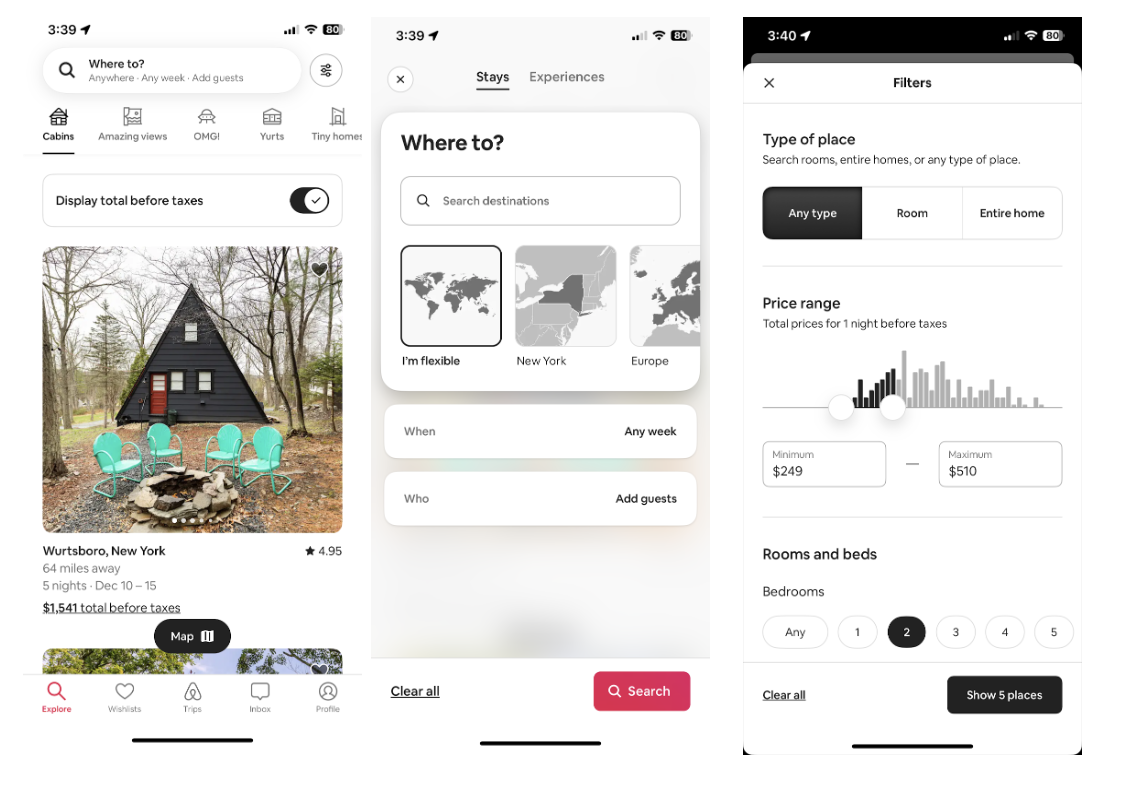
AirBnb Filters
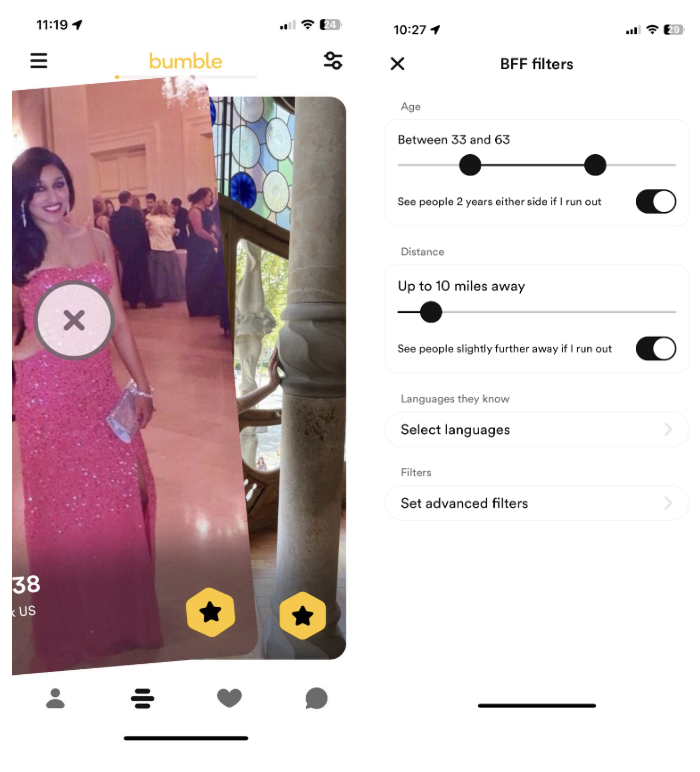
Bumble BFF Filters

ADPList Messaging

AirBnb Messaging

Bumble Messaging

ADPList Profiles

AirBnb Listing Profiles

Bumble BFF Profiles
Based on our comparative analysis of other social platforms, I also defined new features for our responsive website that would enhance user experience and add quality control to connections made with the product.
New Features Include:
Connect request & accept system for immigrants and Buddies, so that they can decide who they want to interact with instead of receiving unsolicited messages (present on ADPList, Bumble BFF (matching), Hinge (matching), LinkedIn, Yelp, Instagram)
“My Buddies” section where immigrants can see the Buddies they’ve connected with (mutual connect request & acceptance made) (present on ADPList, Airbnb (Listings), Upwork (My Jobs), LinkedIn (My Connections), Instagram (Followers))
Contact Us system through our messaging so users can ask questions to the business and report unwanted behavior (mechanism is present in all products)
I asked a team member to create a user journey map (below) of an immigrant’s experience with our potential Immigrant Buddies product. This helped us uncover friction points, resulting in feature ideation and a list of assumptions to test, shown below.
3. Design
I conducted 5 usability tests of the previous Refugee Buddies mobile app prototype to inform our new responsive website design.
Our team’s hypothesis is that a responsive website design would be accessible to all audiences across all devices and not cause friction with an app download process. Thus, we decided to start by designing a responsive website first, with the future possibility of a native mobile app.
Since I already had a working prototype of my previous hackathon solution Refugee Buddies, I decided to test the intuitiveness of our former design to see if we could use some of the same navigation and flow in our new mobile version design of the responsive website.
See the results of our test here, and a summary of the results on the right. Since the usability tests garnered positive results, we concluded that we can borrow a lot of the flows, functions, and navigation in the new mobile web version of our responsive web platform.
I wrote a solution statement that hypothesizes what our concept of immigrant-Buddy mentorships will accomplish:
“We believe that by connecting new immigrants with local mentors and friends, they will integrate and adjust to life in America more smoothly and efficiently, helping them accomplish their goals of why they came here.”
To test our concept before we develop the technology product, I constructed a manual Buddy program (concierge MVP test) where I paired immigrants with Buddies personally through Google Form signups, Excel sheets, and video calls. I designed a preliminary website where immigrants and Buddies could register for the program.
The manual Buddy program (concierge MVP test) operates like this: immigrants and Buddies sign up on our website through our embedded forms. I meet with the immigrants to learn more about them and give them the full list of Buddies, and they choose the Buddies with whom they want to connect. I reach out to the Buddies to see if they're available; if so, then I introduce the immigrant and Buddy to each other in a kickoff call where they learn about each other, set goals for the partnership, and establish communication methods. Then the immigrant and Buddy take it from there, and I follow up periodically for feedback and support to evolve our program and product.
This manual connection method was meant to mirror the functionality of our future product. My goal was to see whether this type of mentorship and connection would result in value for both sides and how these connections would play out in real life.
Current Preliminary Website (www.immigrantbuddies.com)
Current Concierge MVP Process
After a few months of the manual Buddy program, I surveyed immigrants and received responses from 4 participants. Positive survey results (shown below) validated our hypothesis and proved that our concept provides value for immigrants by helping them integrate.

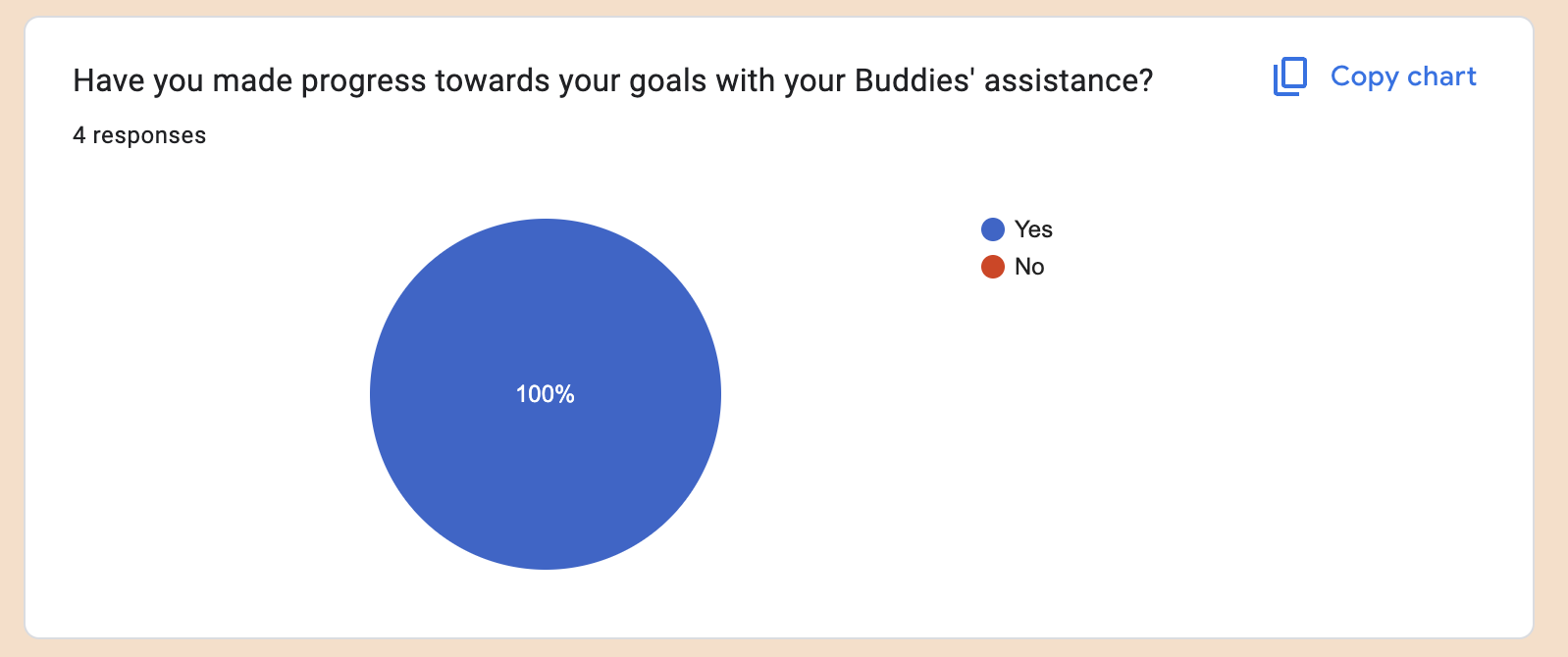






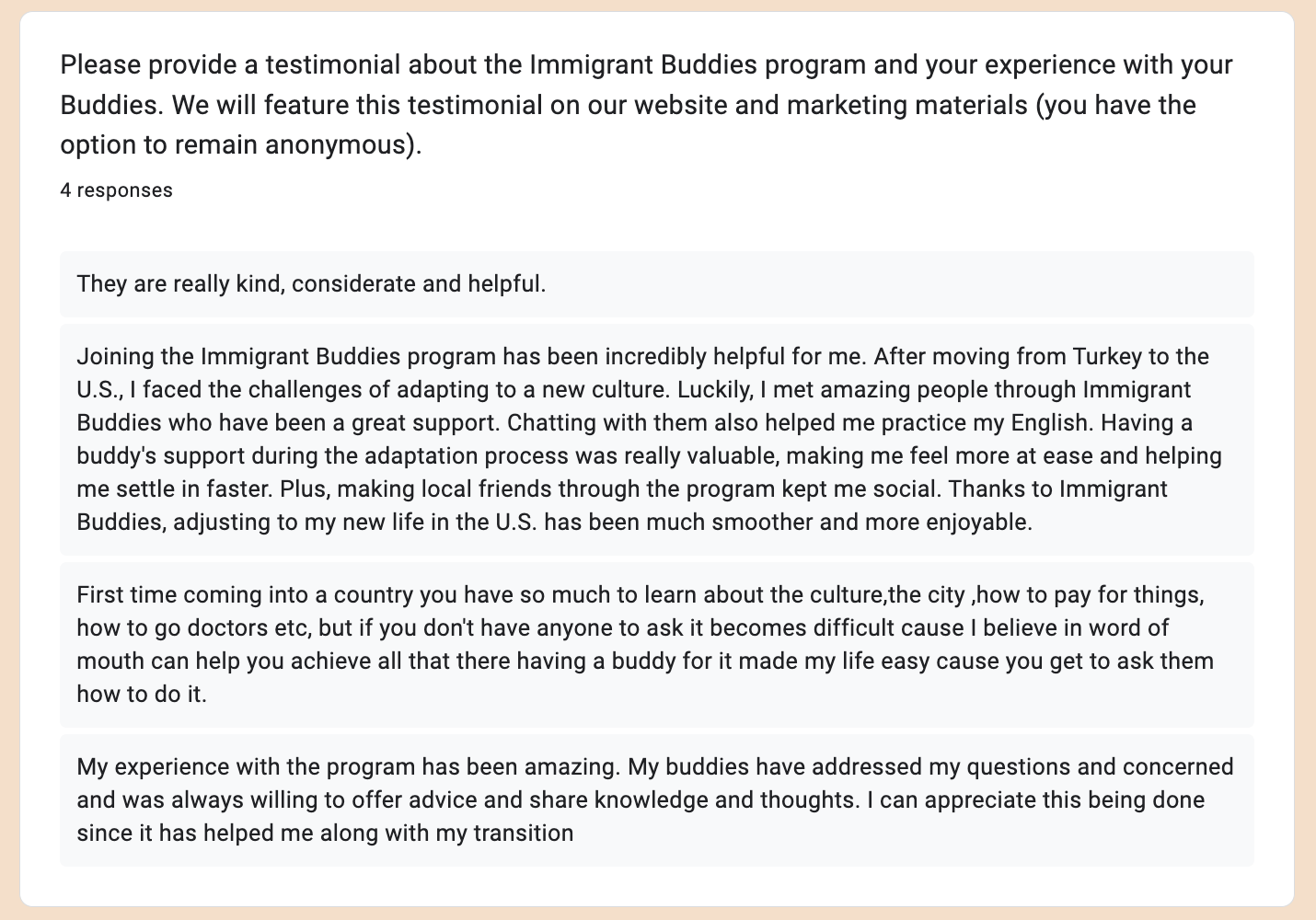
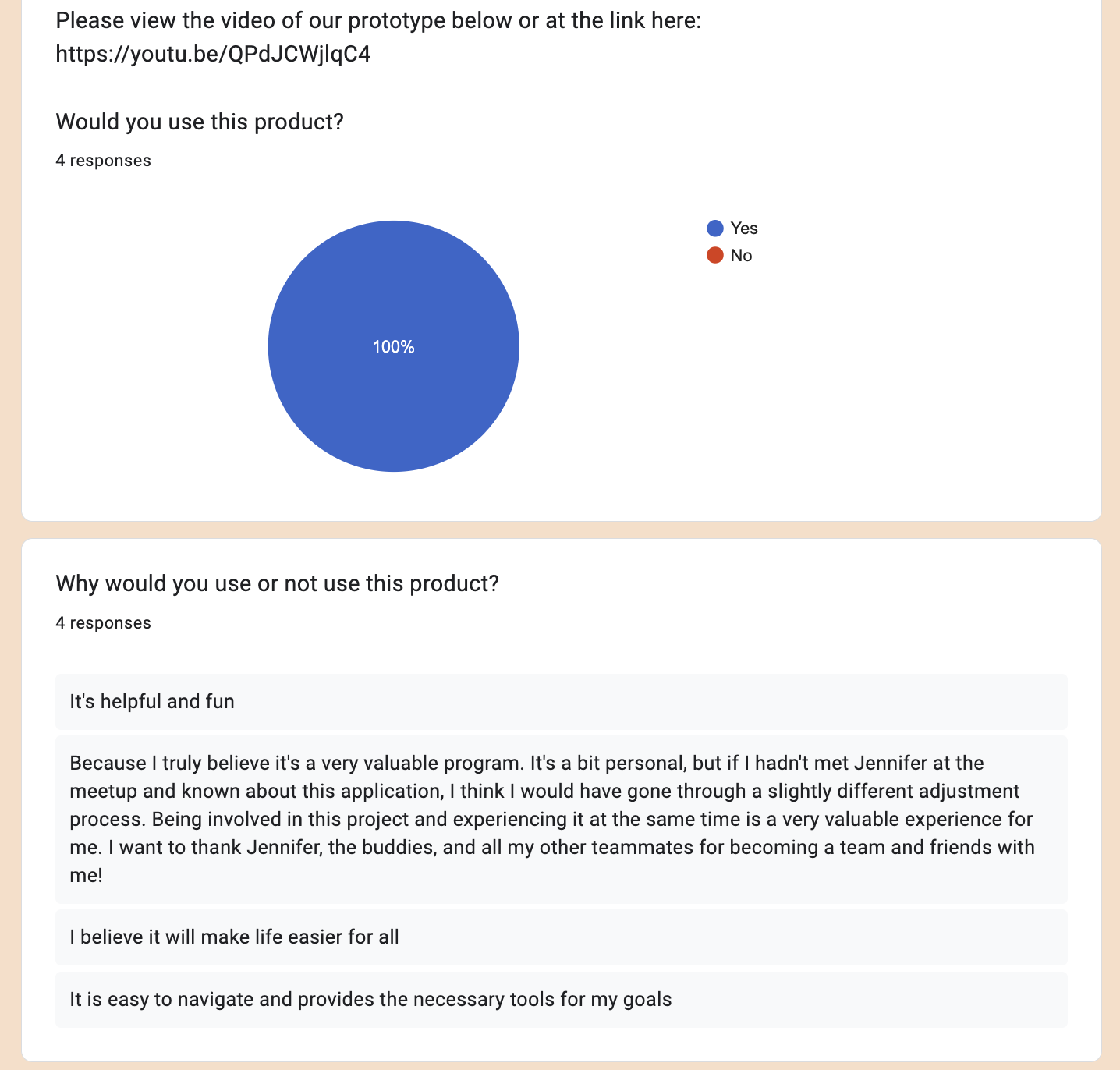
I also surveyed Buddies and received responses from 4 participants. Positive survey results (shown below) validated our hypothesis and proved that our concept provides value for Buddies by giving them a rewarding experience of helping others and of cultural exchange.





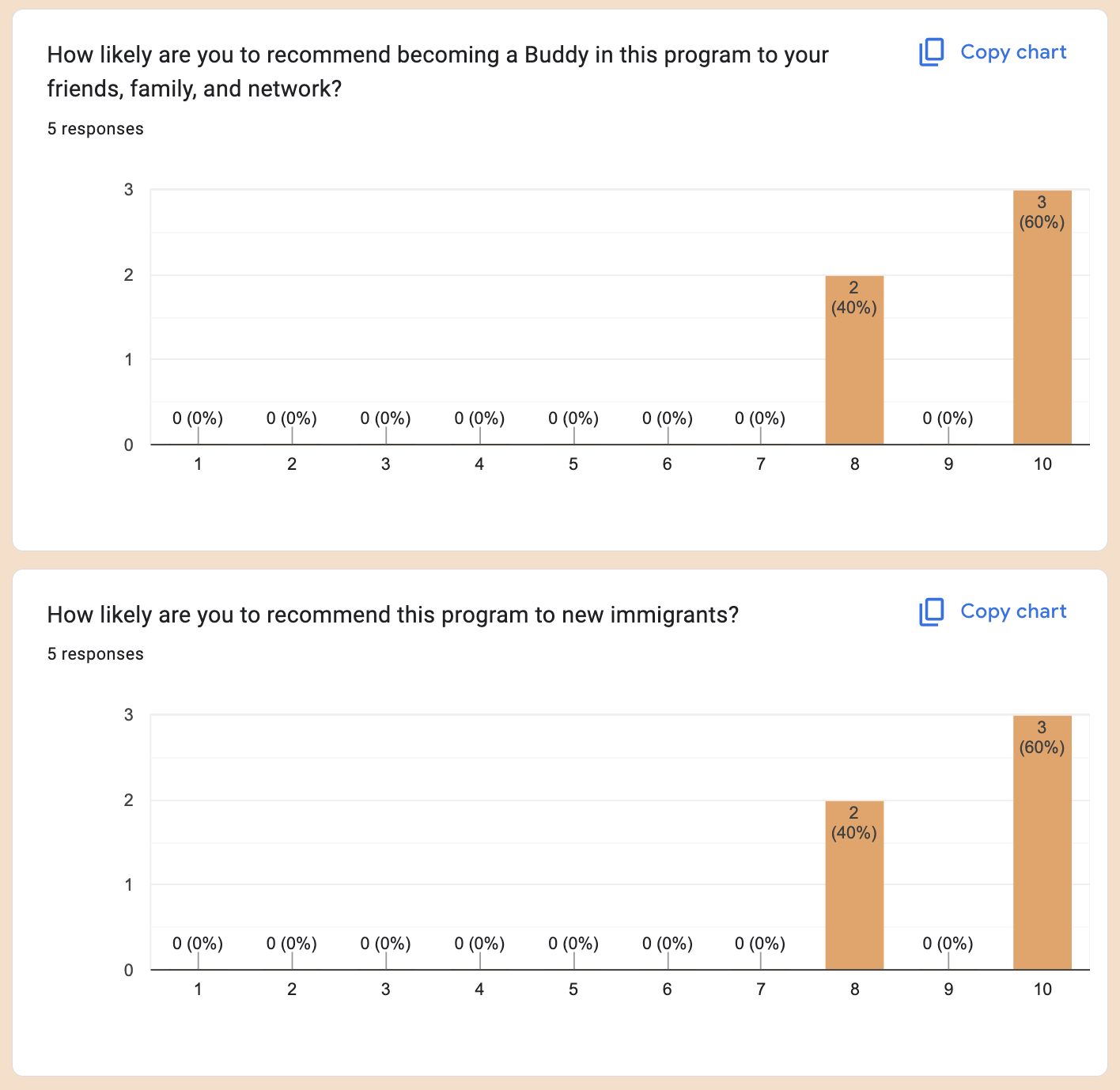


Since our concierge MVP validated the concept, I felt confident about moving forward with the design and development of the tech product.
I continued the design process by asking 2 team members to create user flows of both the immigrant and Buddy sides (see screenshots below) to illustrate a user’s journey while using our product based on different scenarios and decisions.
Next, I asked 2 team members to create site maps of both the immigrant and Buddy side (see screenshot of immigrant side MVP below) to illustrate the navigation and information architecture of our future platform.
I made a series of sketches below to illustrate the flow, features, and layout of the Immigrant Buddies web platform. Here are the sketches of the desktop and mobile screens from the immigrant side.
Desktop Screens
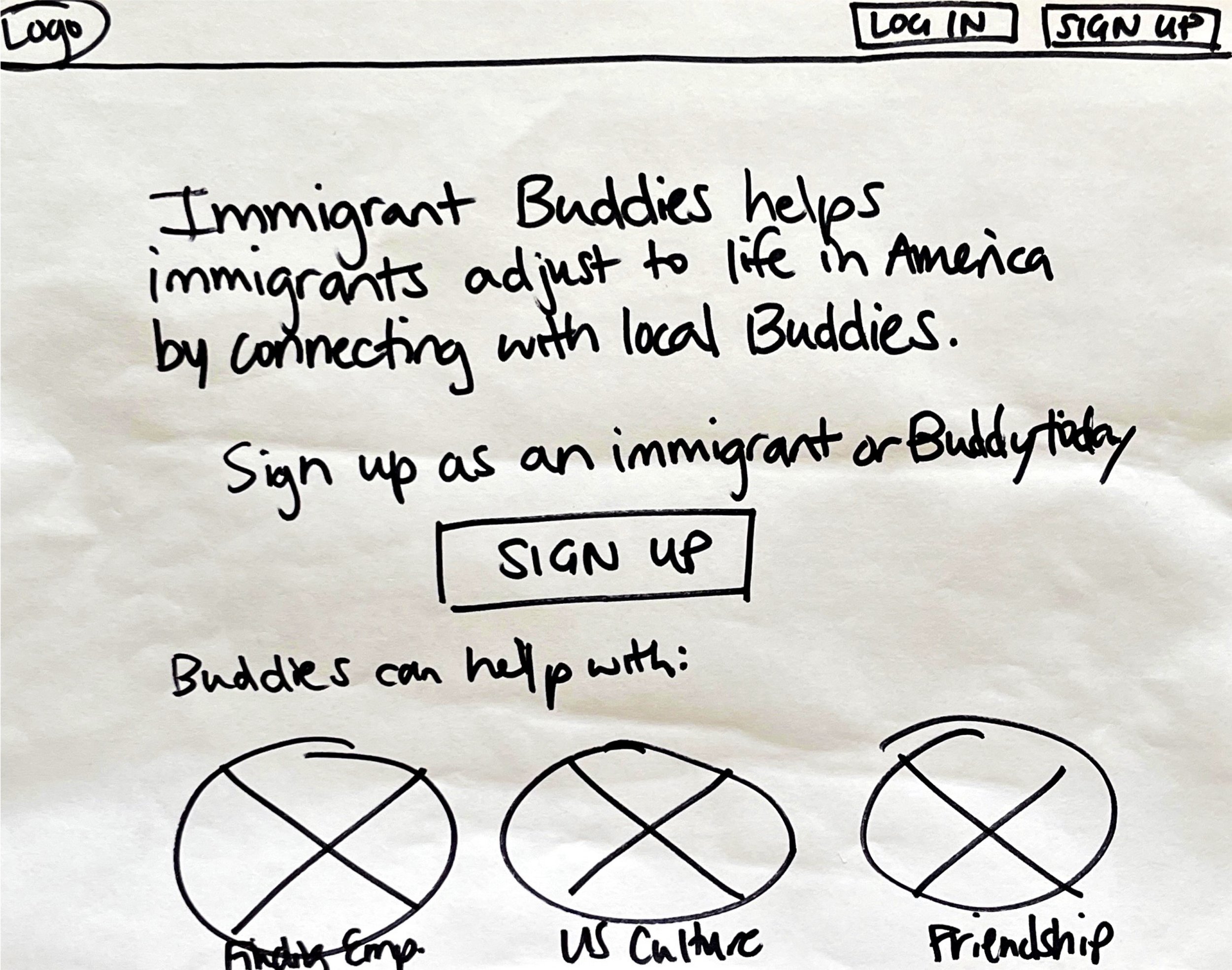
1. Desktop: Home before Login

2. Desktop: Sign Up
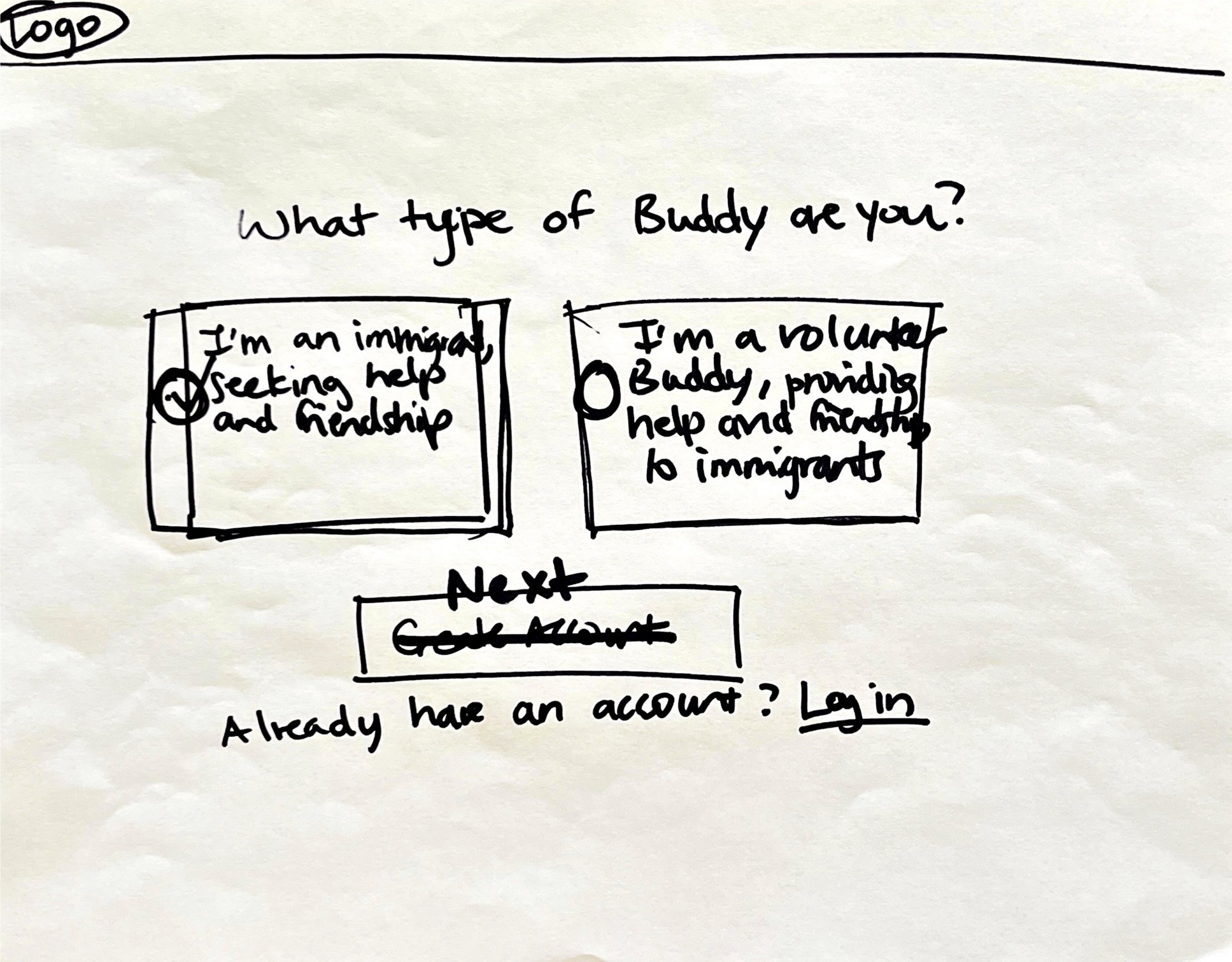
3. Desktop: Register- Immigrant or Buddy

4. Desktop: Register- Areas of Help
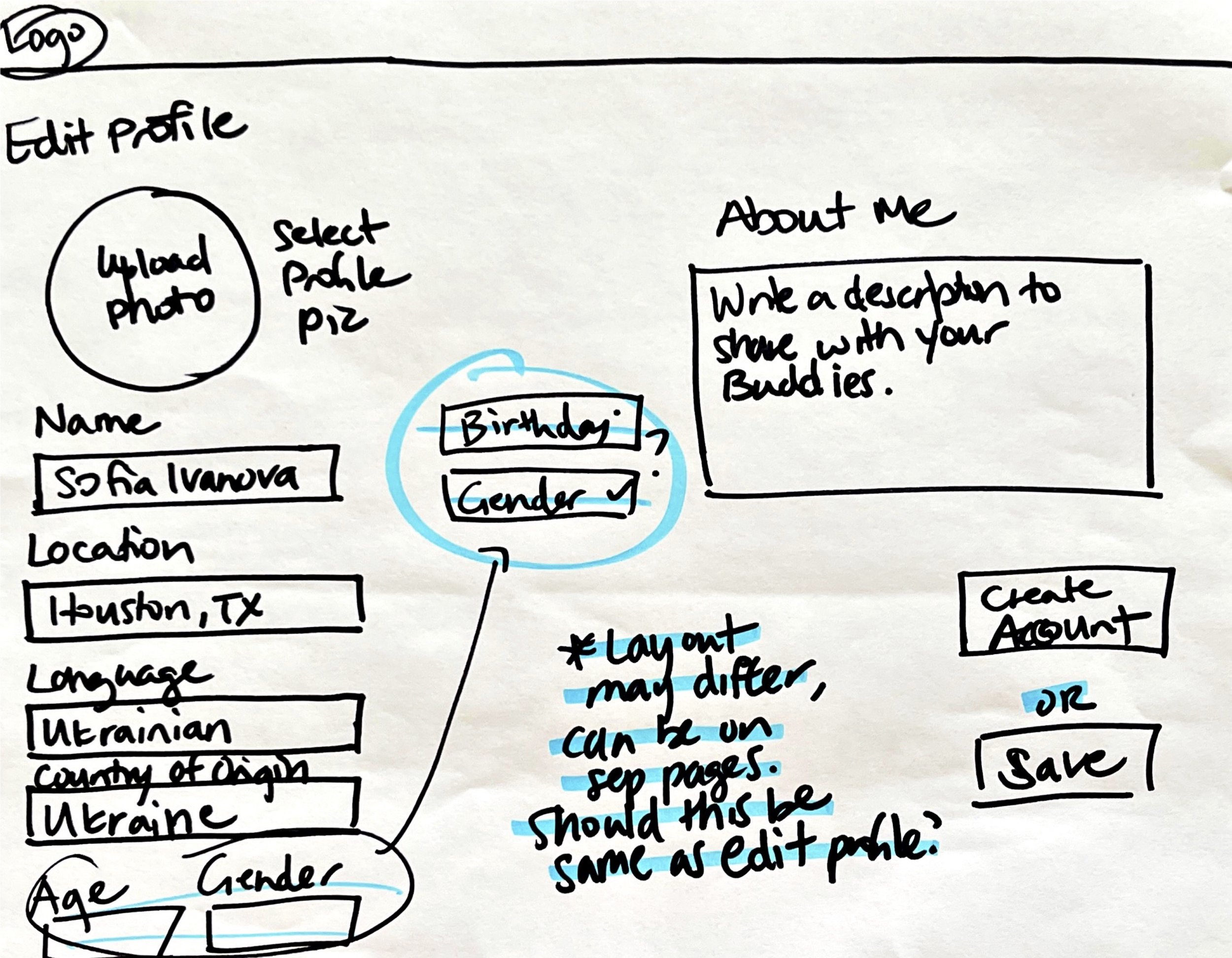
5. Desktop: Register- Edit Profile
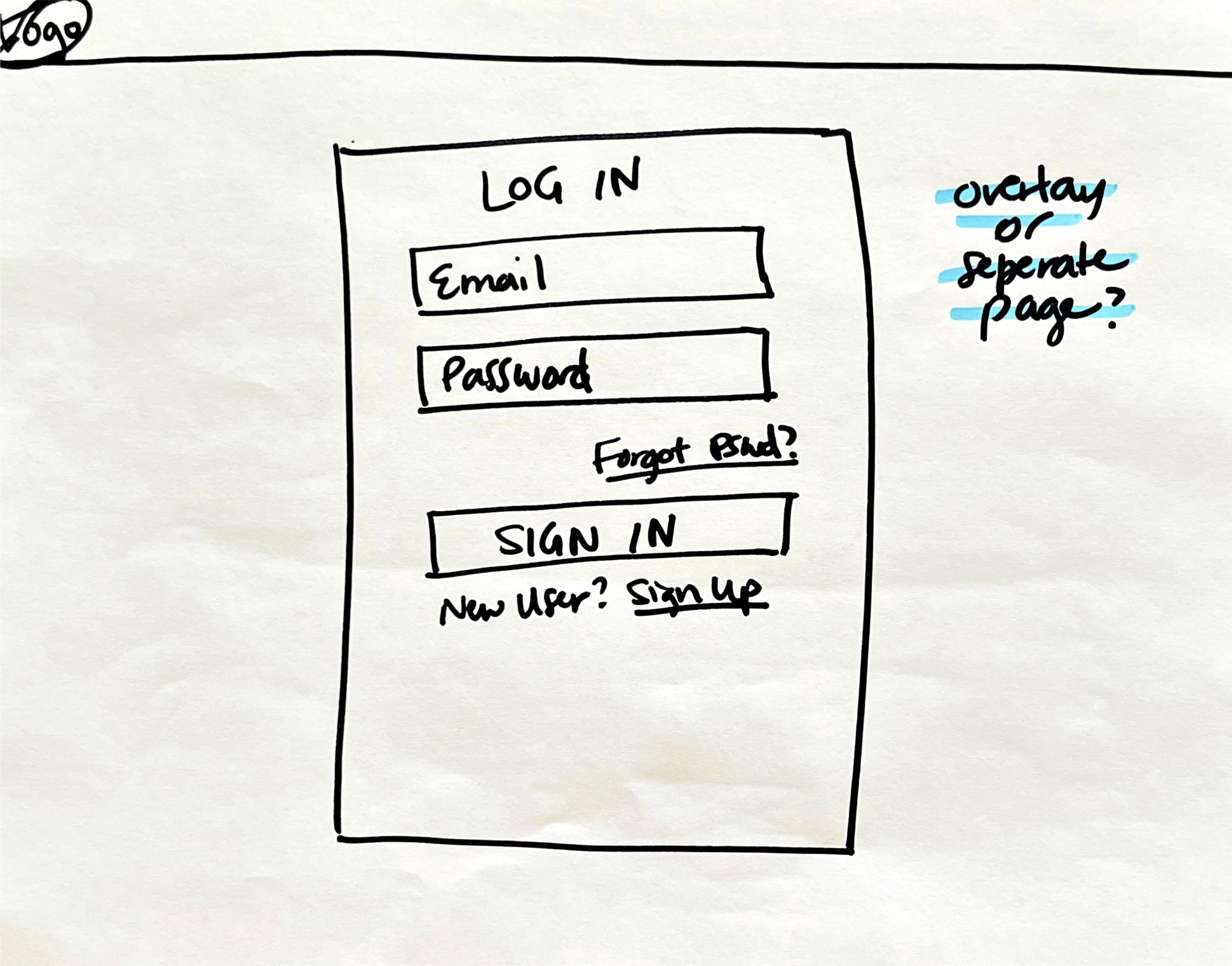
6. Desktop: Login
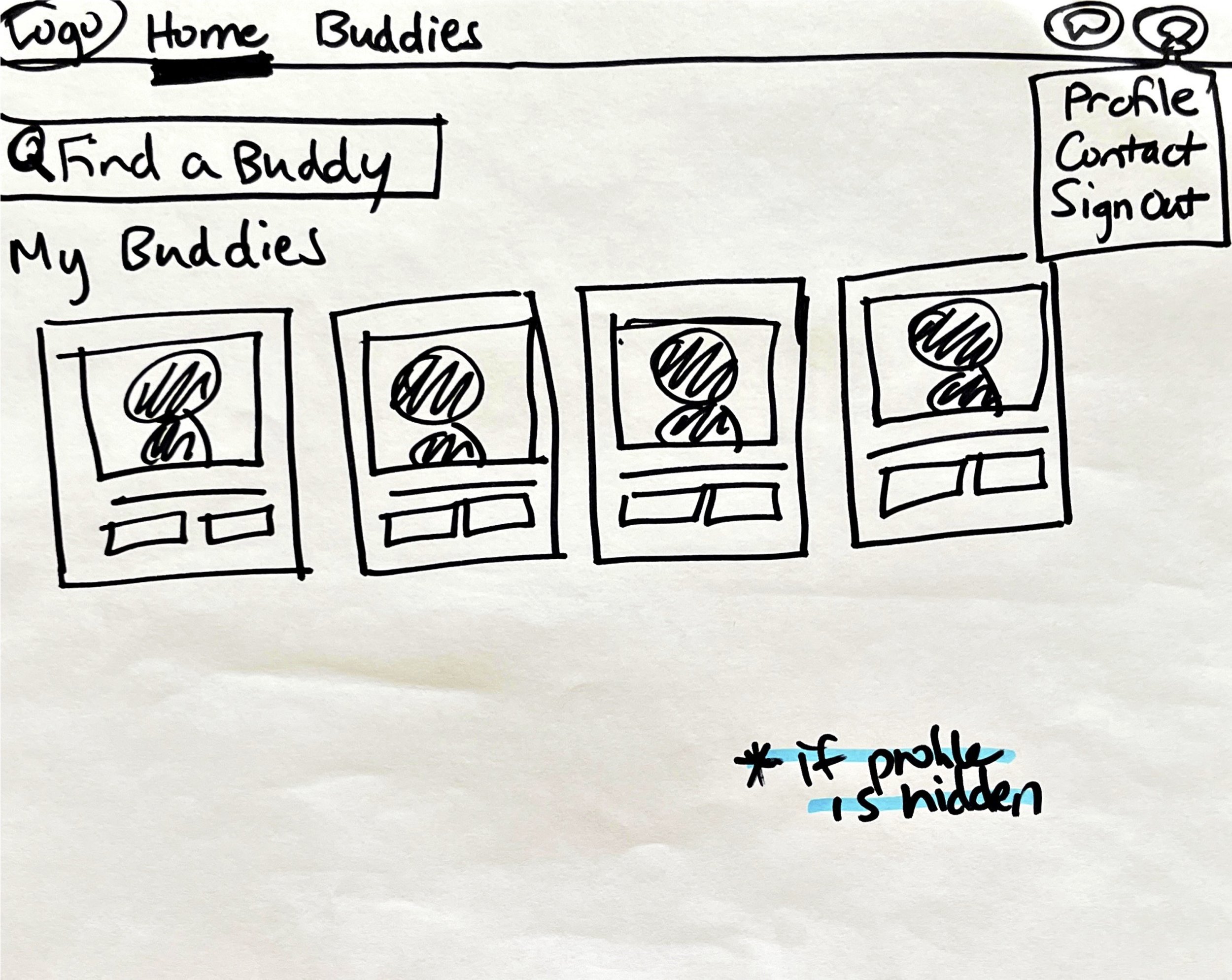
7. Desktop: Home after Login
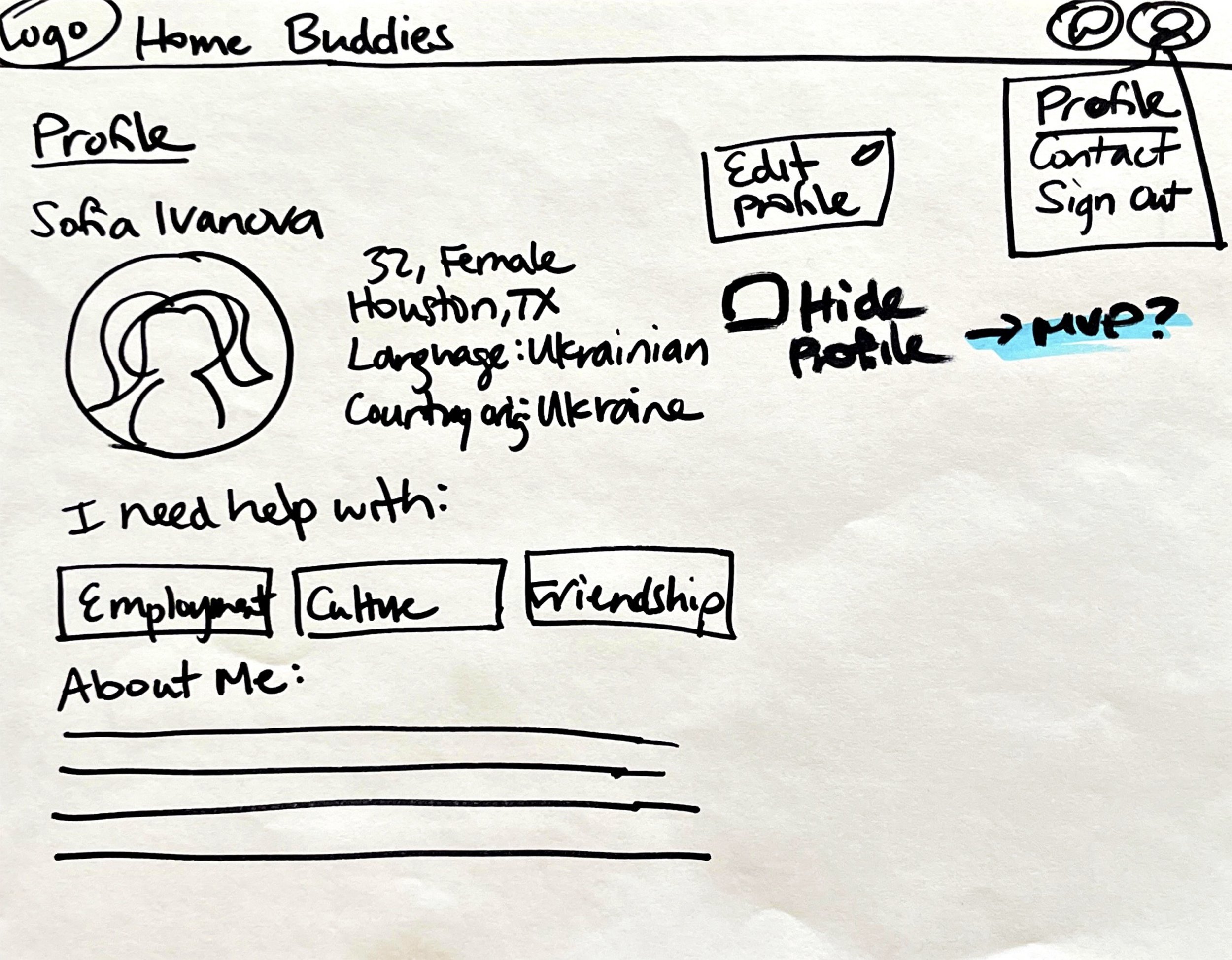
8. Desktop: Profile

9. Desktop: Buddies
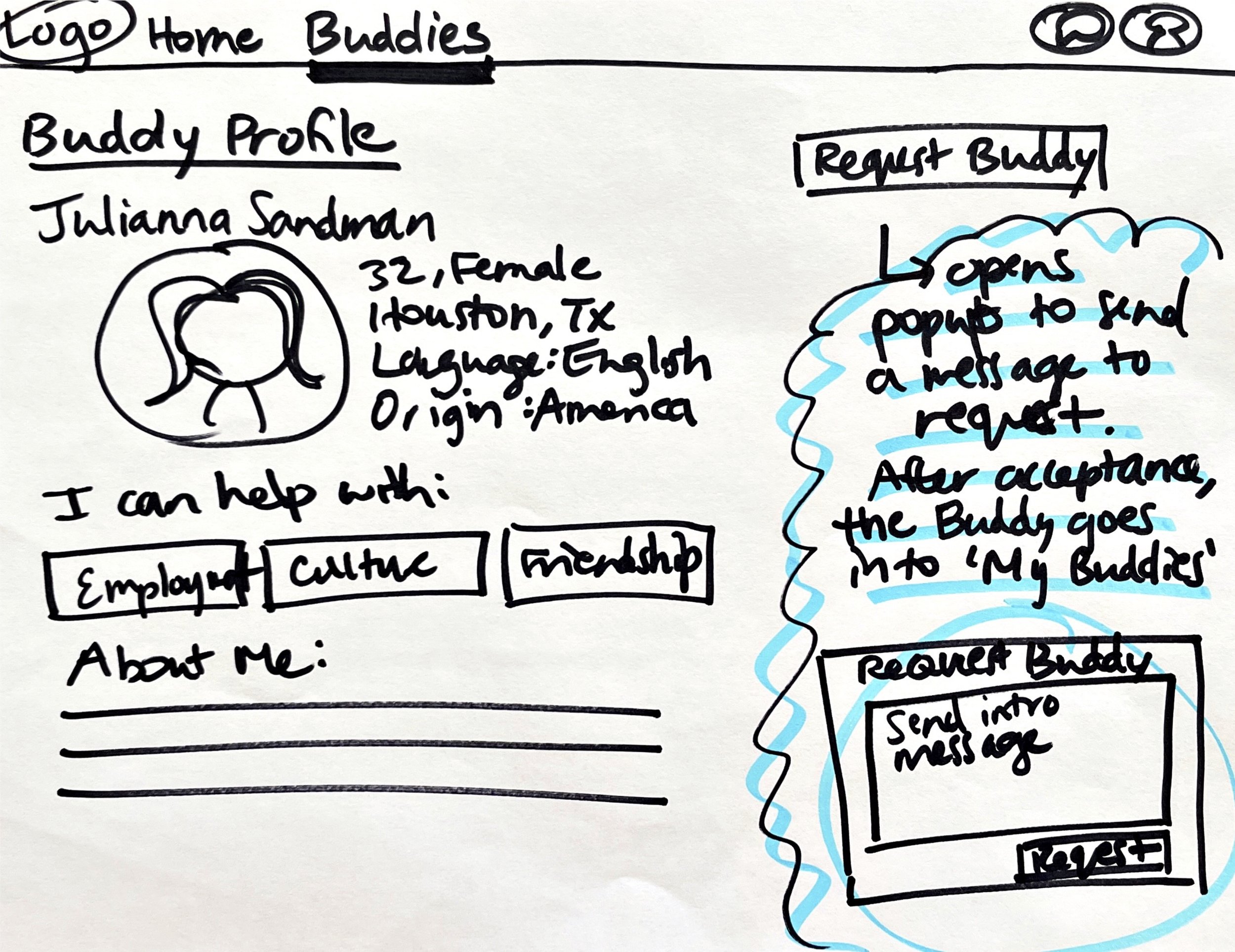
10. Desktop: Buddy Profile
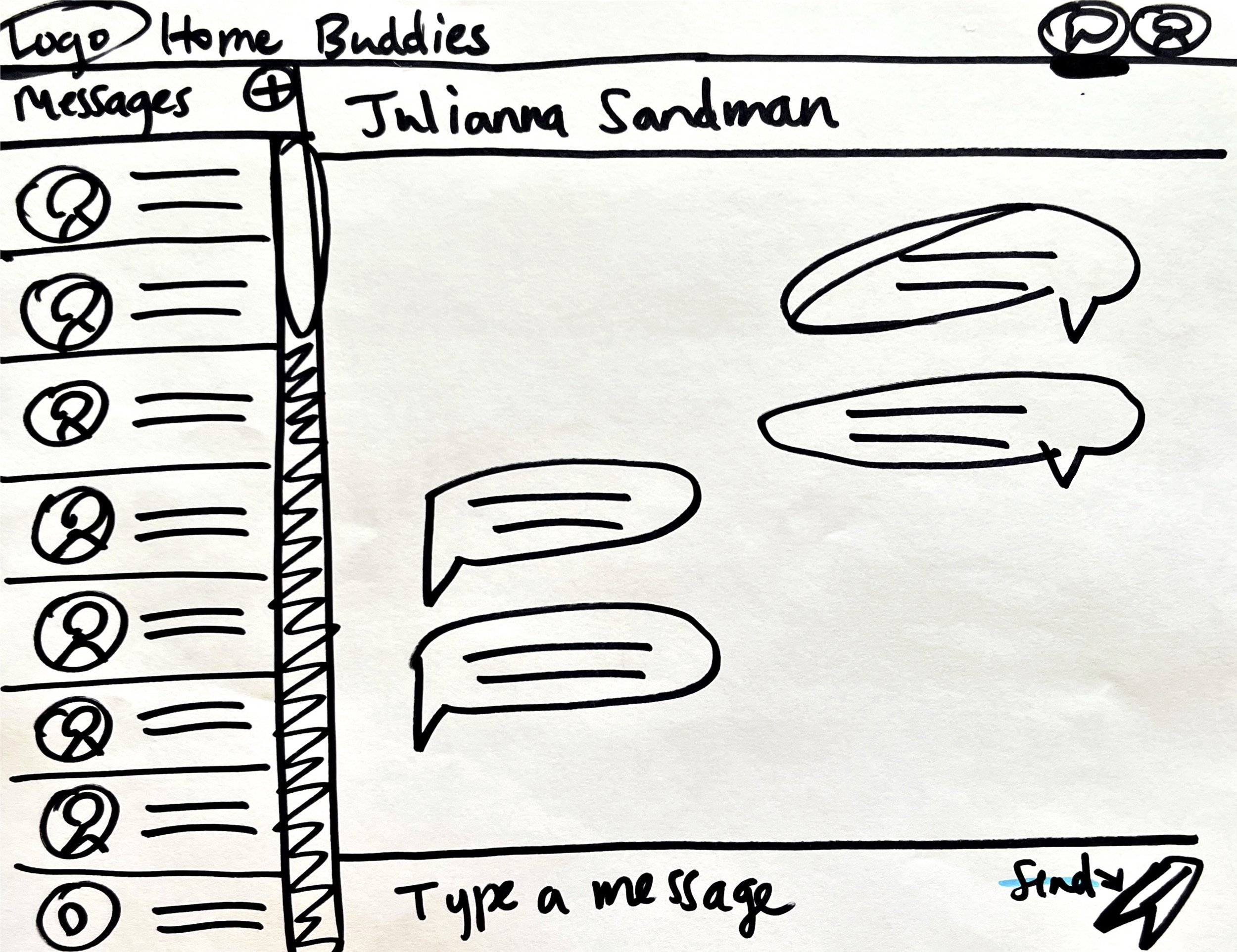
11. Desktop: Messages
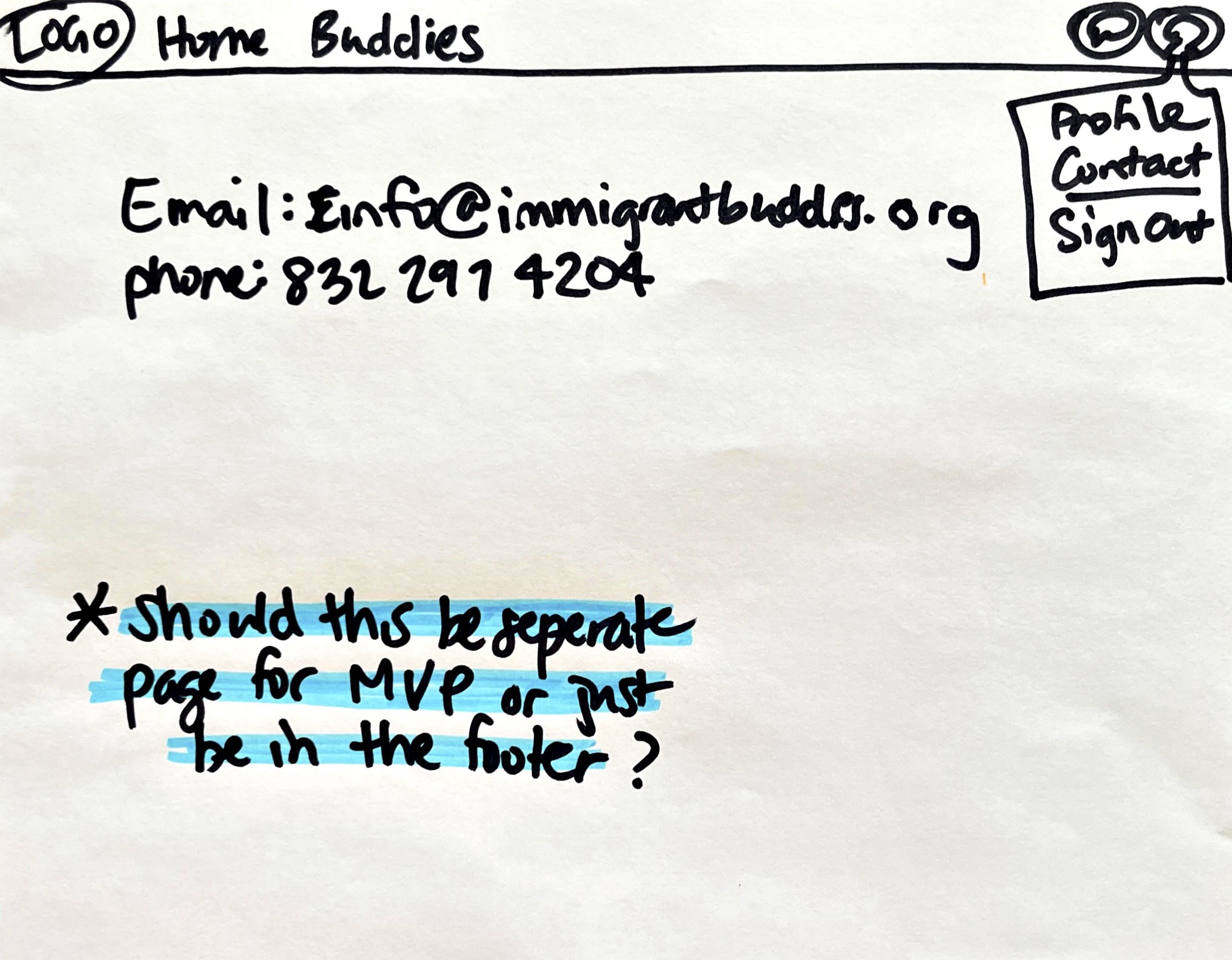
12. Desktop: Contact Us
Mobile Web Screens
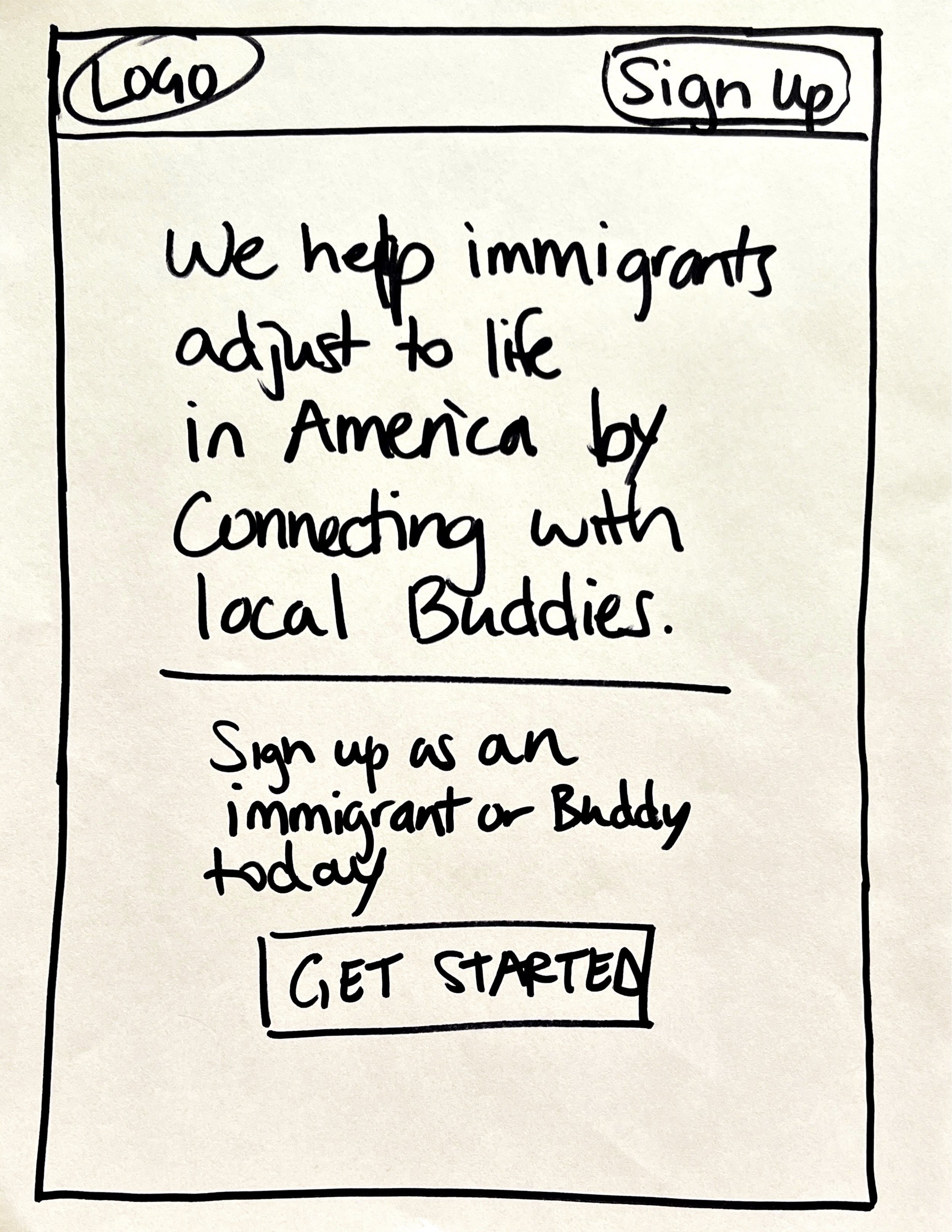
1. Mobile Web: Home before Login
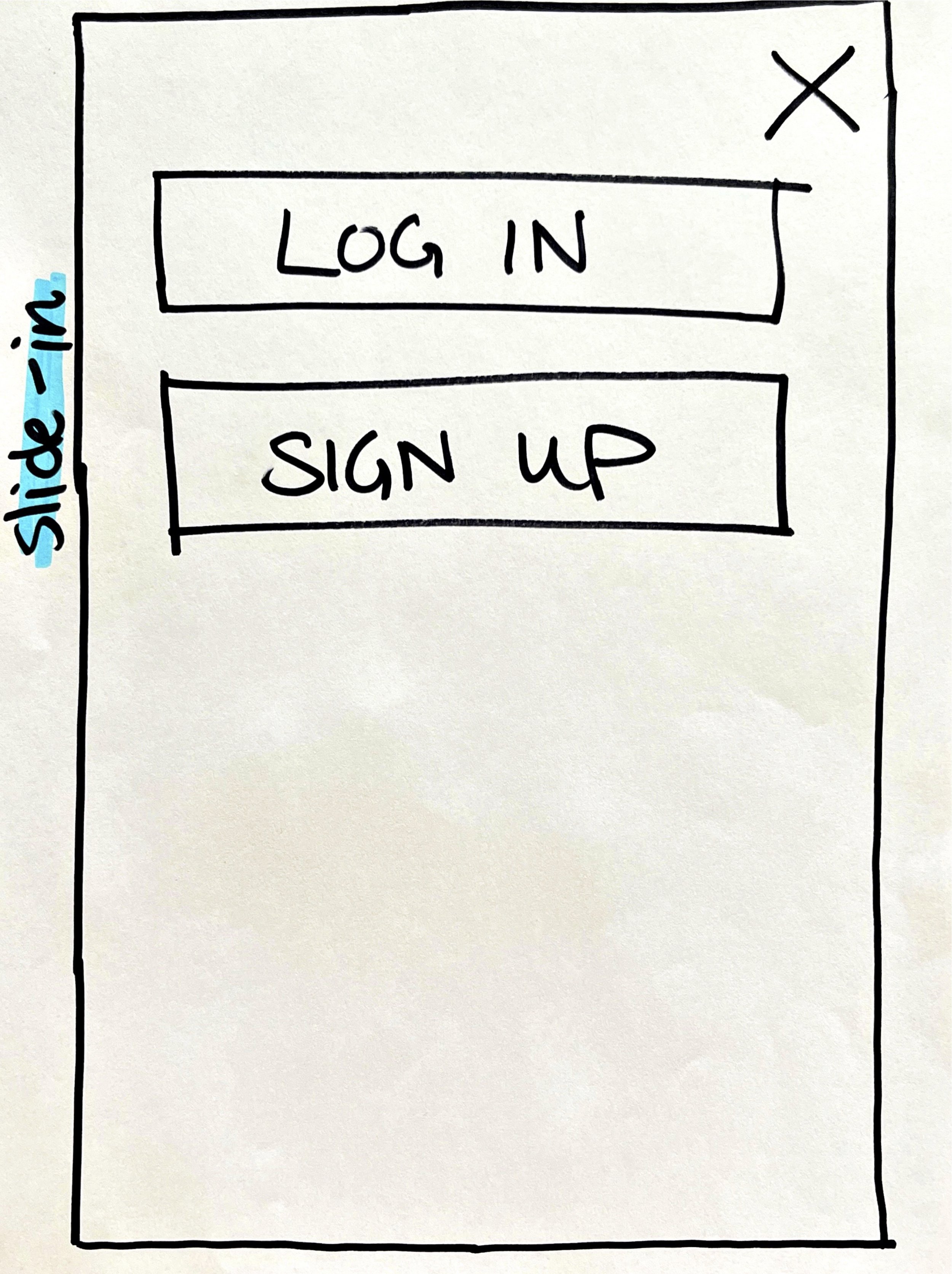
2. Mobile Web: Login and Signup from Menu
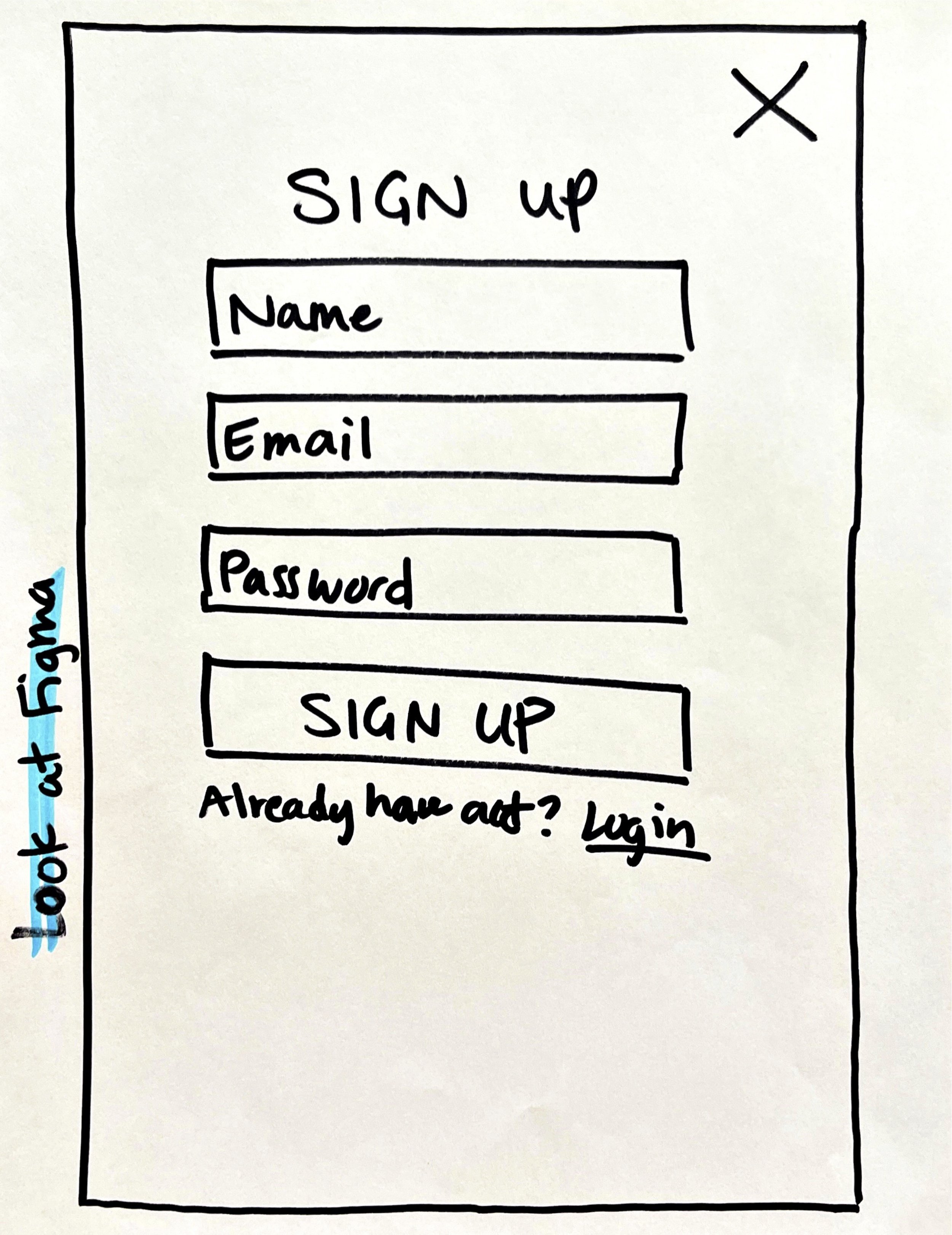
3. Mobile Web: Sign Up

4. Mobile Web: Register- Immigrant or Buddy
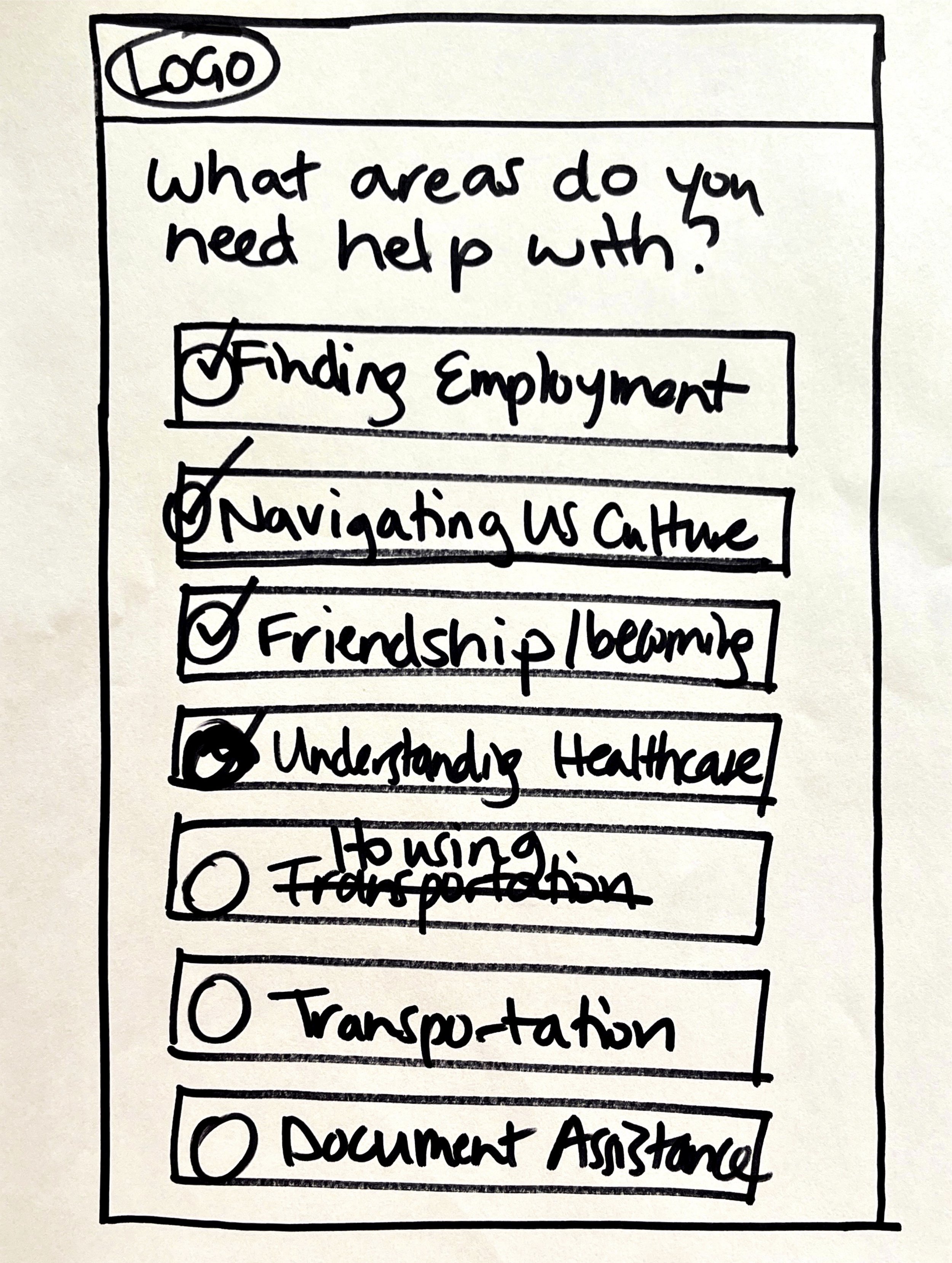
5. Mobile Web: Register- Areas of Help
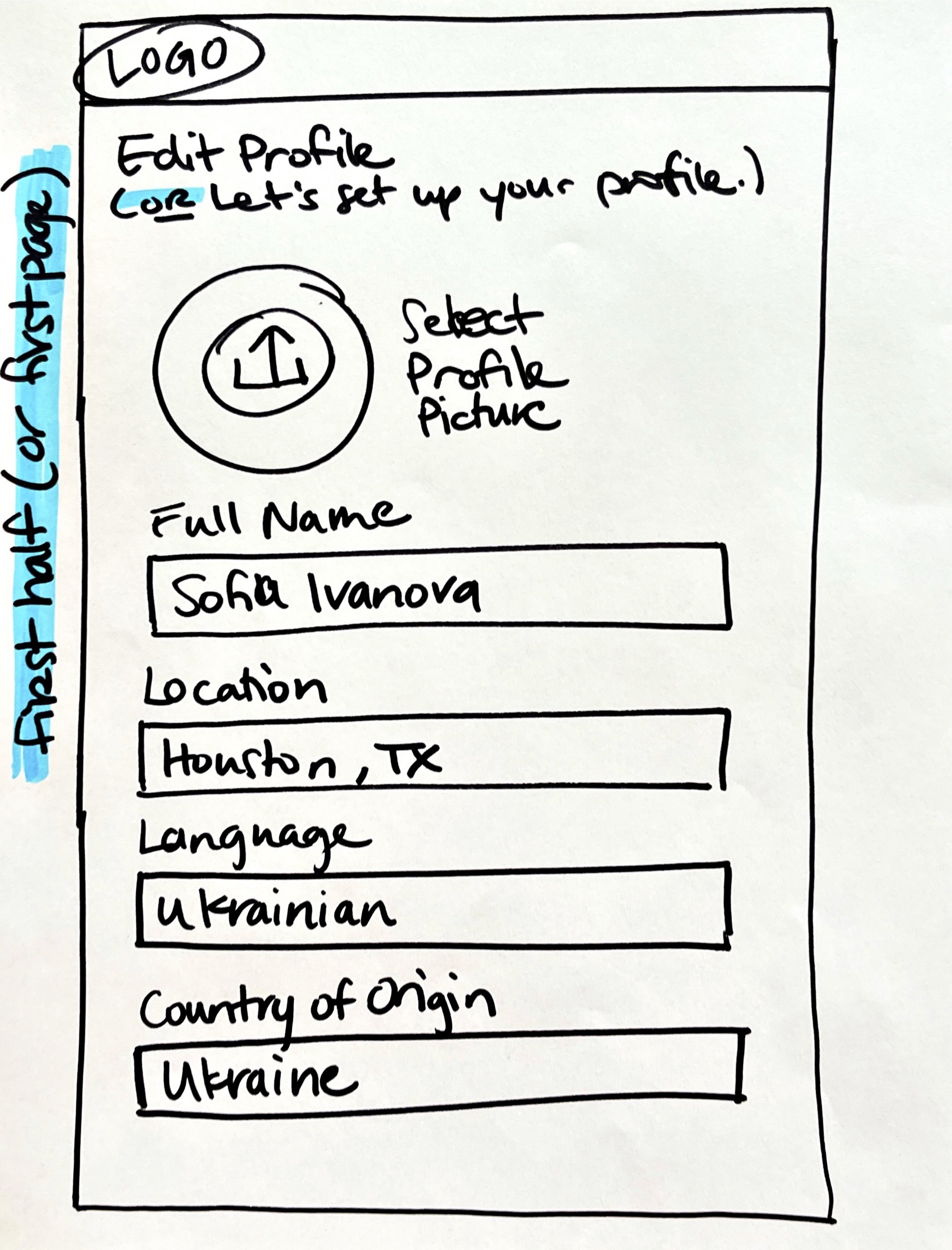
6. Mobile Web: Register- Edit Profile
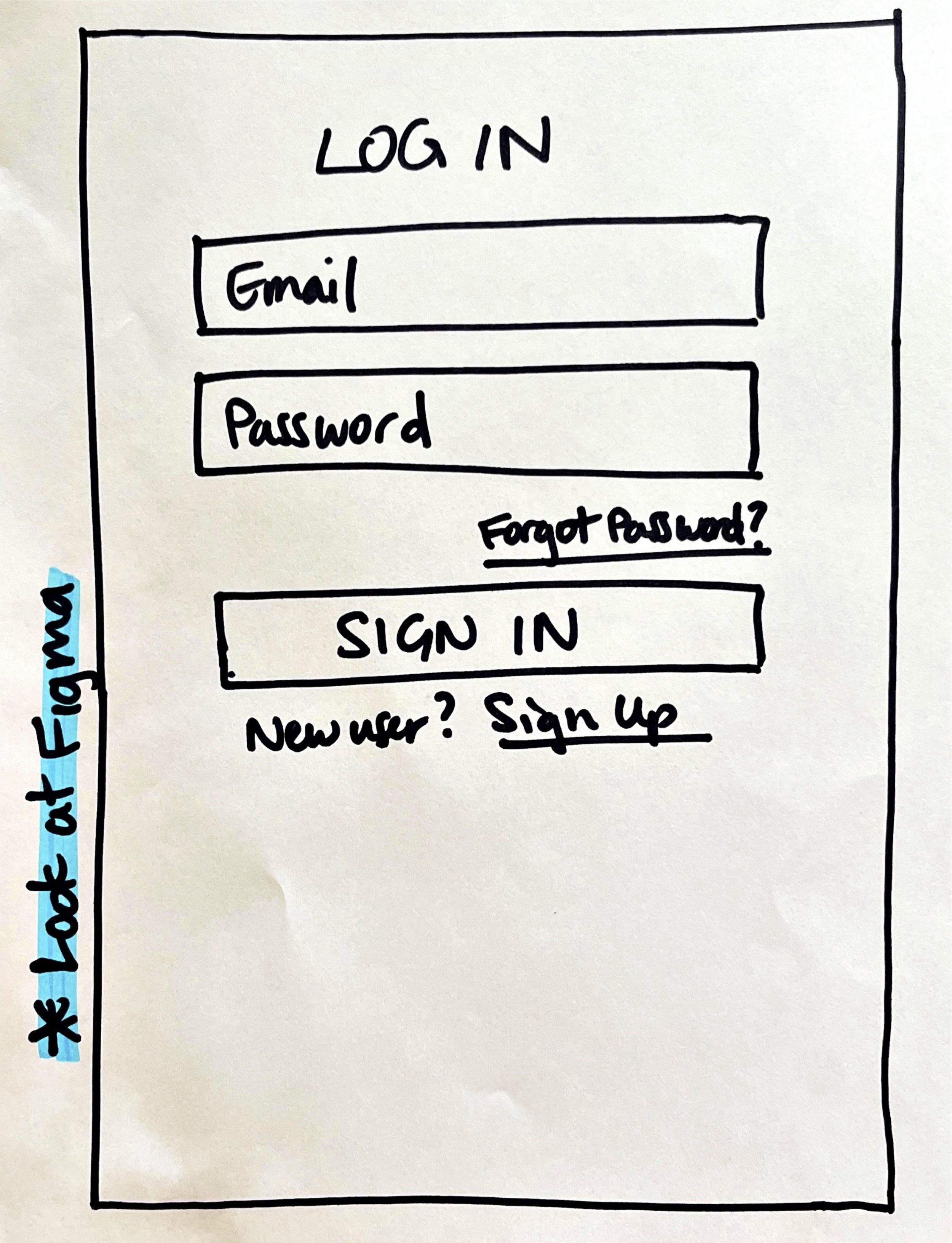
7. Mobile Web: Login

8. Mobile Web: Home after Login
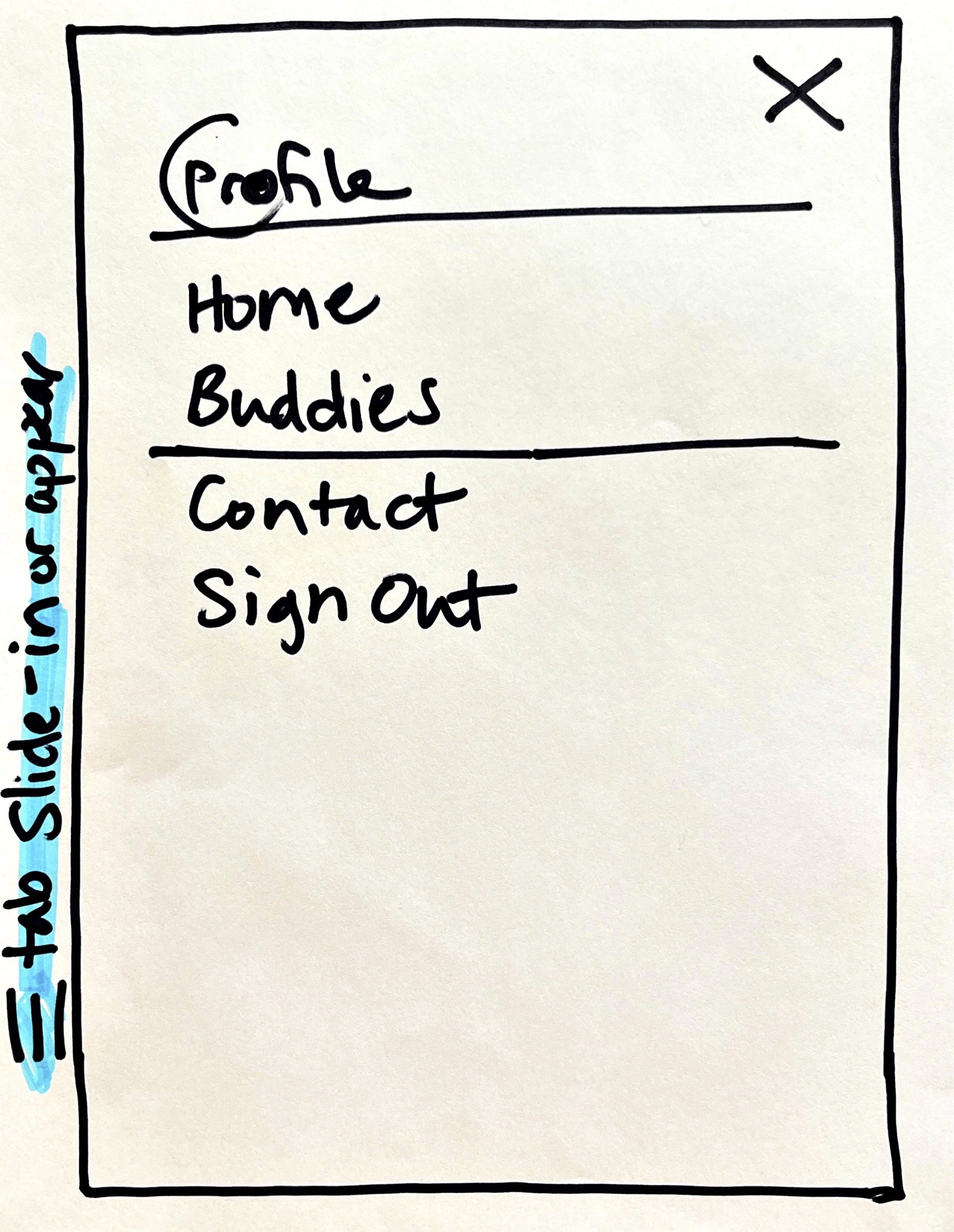
9. Mobile Web: Upper Right Menu after Login

10. Mobile Web: Profile

11. Mobile Web: Buddies

12. Mobile Web: Buddy Profile

13. Mobile Web: Request Buddy

14. Mobile Web: Message List
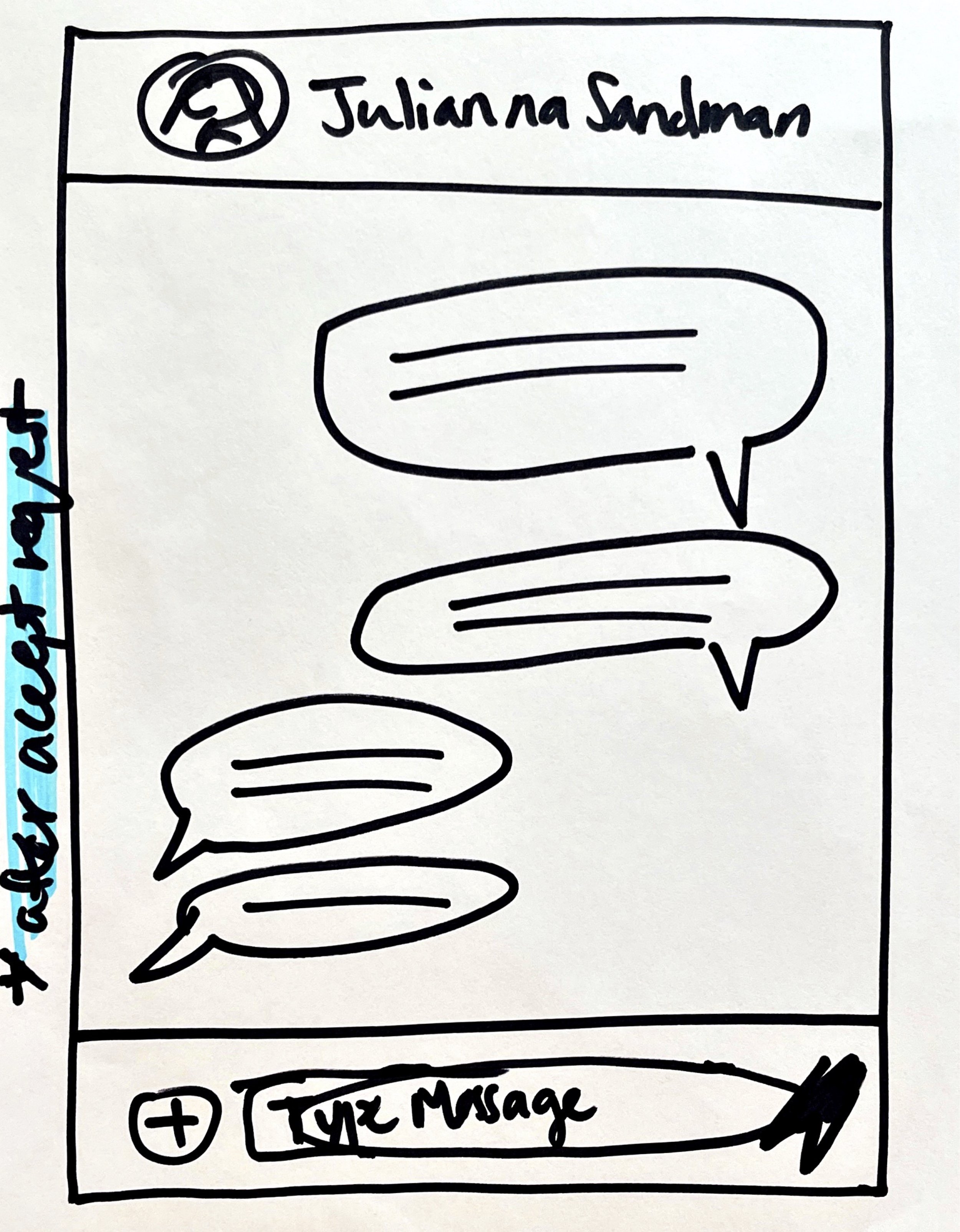
15. Mobile Web: Compose Message

16. Mobile Web: Contact Us
We used the sketches to design the first low-fidelity Figma wireframes for mobile and desktop. Then I constructed a V1 mobile web prototype to test with users.
I asked my team to conduct 10 usability tests (2 tests per person) on our V1 low-fi prototype for immigrants and buddies to identify gaps in usability.
This test aims to uncover whether certain key functions of the application are easily findable and usable, whether the functionality, navigation, and labels within the app are intuitive, and whether the app solves the users’ main problems quickly and efficiently.
This test was conducted remotely moderated over Zoom for 10 participants (5 immigrants and 5 Buddies). I made a usability test plan with 10 tasks and additional questions to gather feedback.
Participants were all immigrants on the immigrant side and general participants (no specific criteria) for the Buddy side. The tasks we tested and the questions we asked are below.
From the test results, I analyzed the most commonly mentioned issues and points of confusion with this spreadsheet to determine what to change for our V2 prototype.
As a team, we met to discuss the results of our respective tests. I noted all the issues and counted the ones most often noted by users. We implemented changes to the ones mentioned more than once, as well as a few tweaks and others based on our judgment as a group. See the list of changes below (the issues mentioned more than once are in yellow. The green comments represent several points of confusion that resulted in a major navigational change in our product.
For our next version, our group decided to make high-fidelity mobile wireframes. I asked 3 team members who had a graphic design background to first make a design system to determine our branding, layout, typography, color scheme, and common mobile components.
My team members created a comprehensive design system that made our construction of high-fi wireframes more efficient and consistent. See sample guidelines for mobile web below.
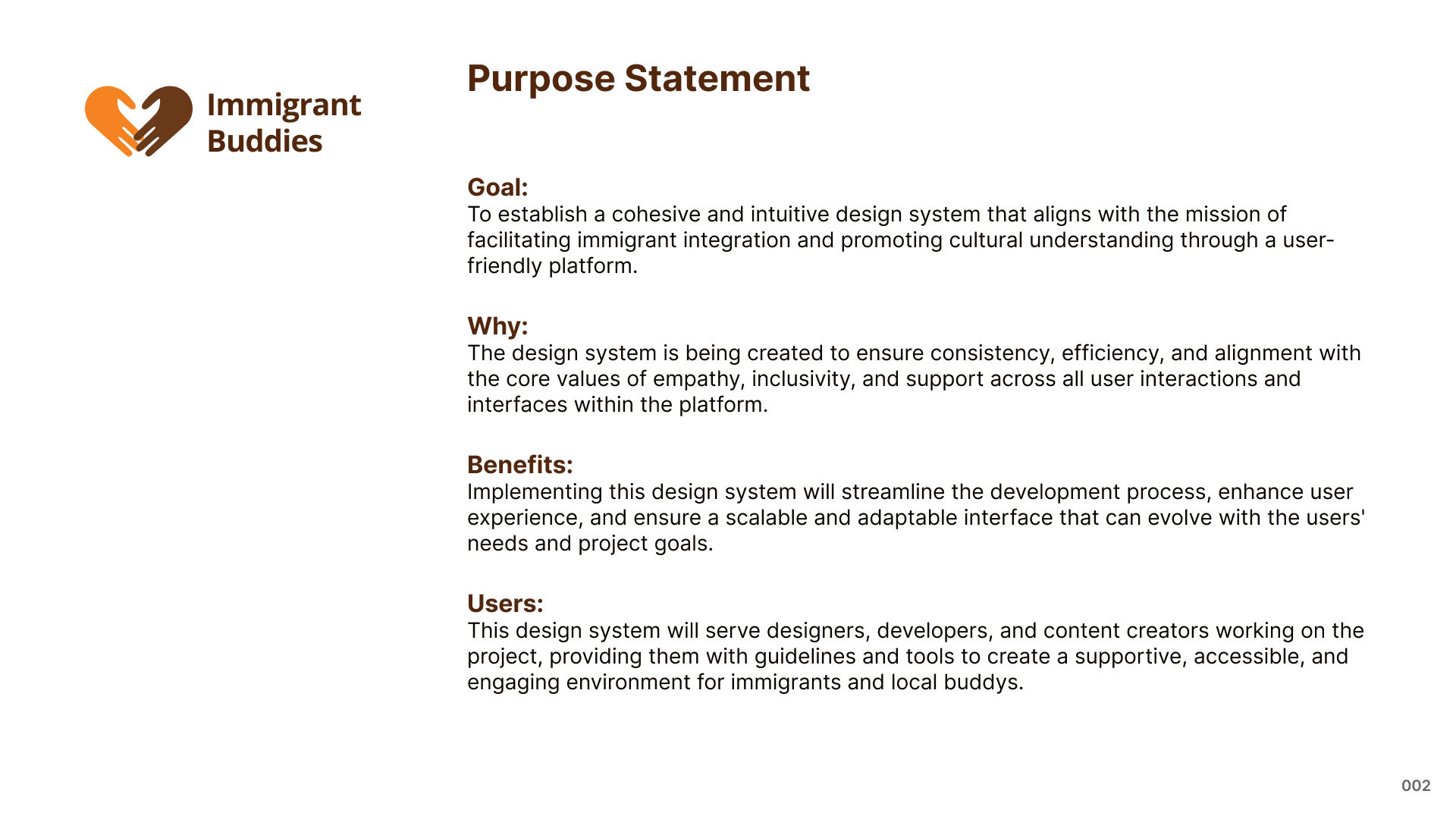
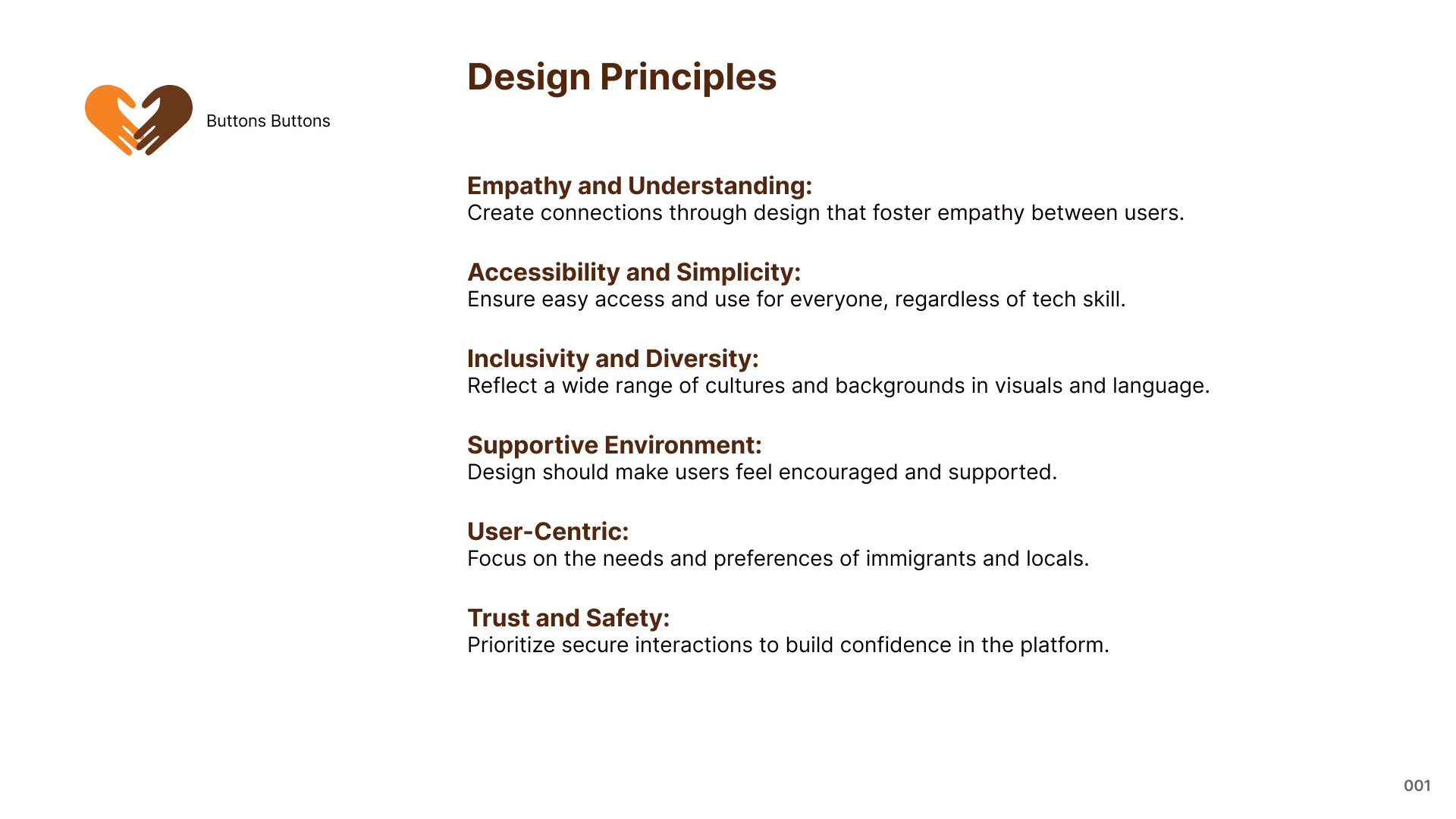
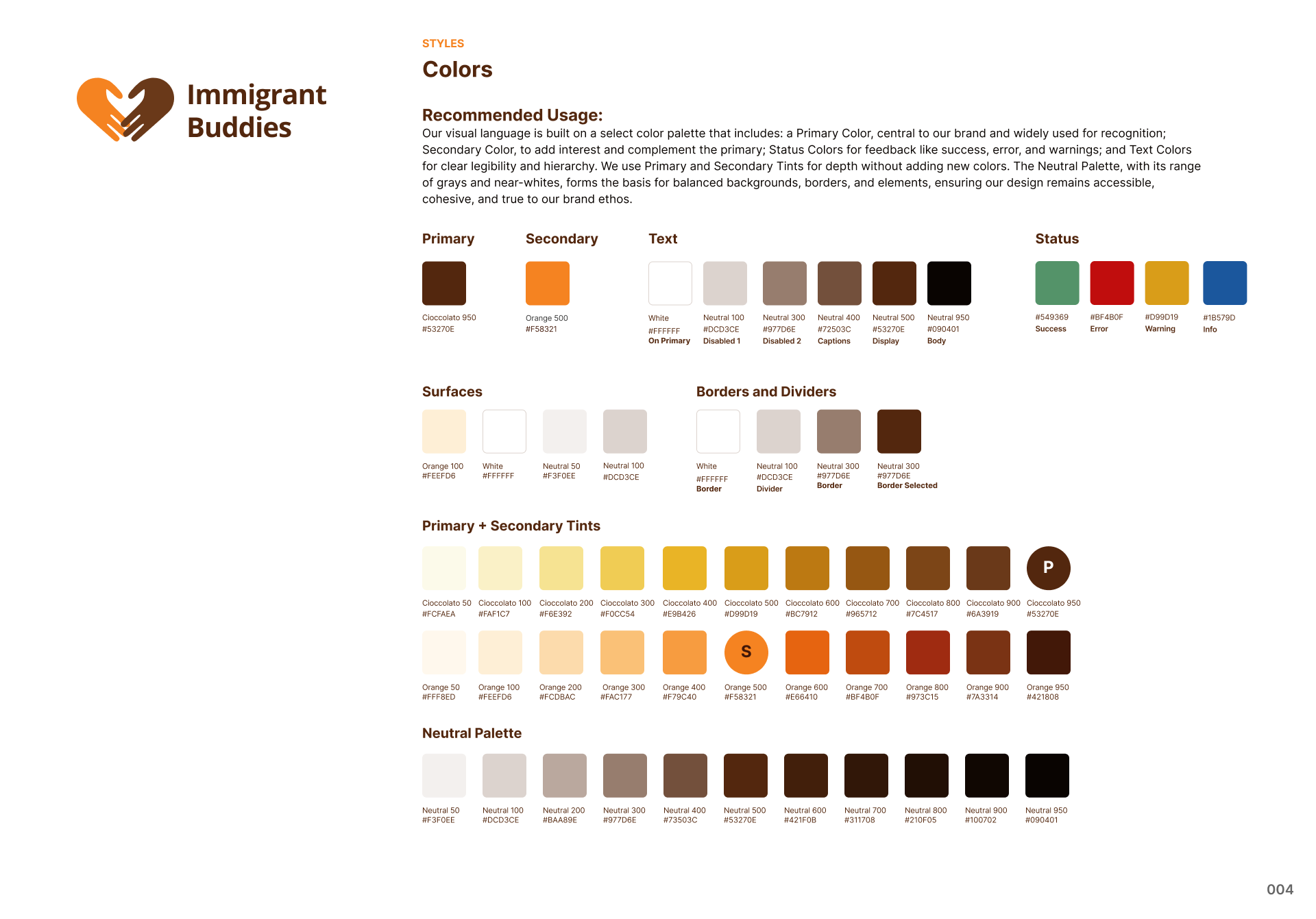

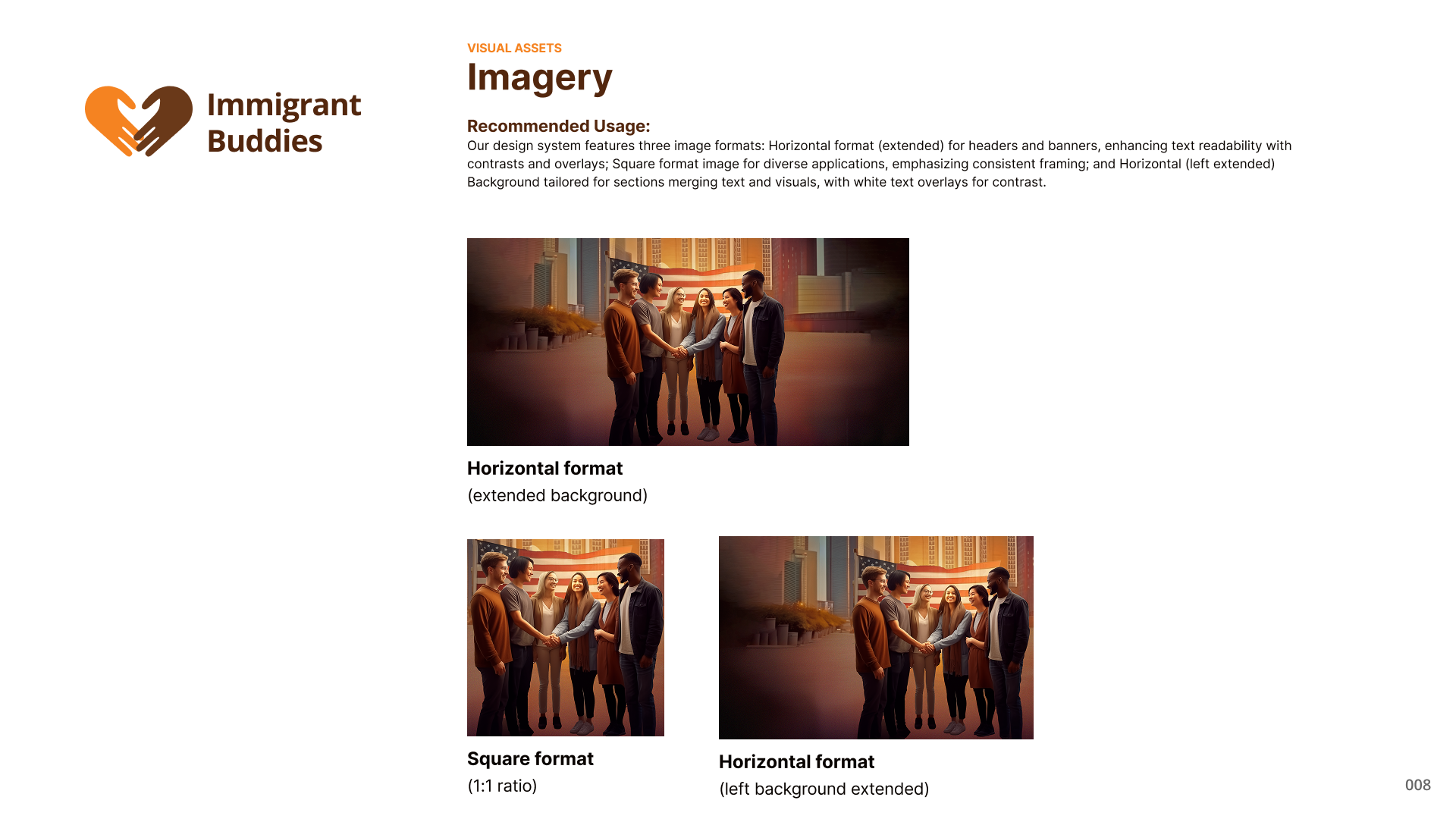


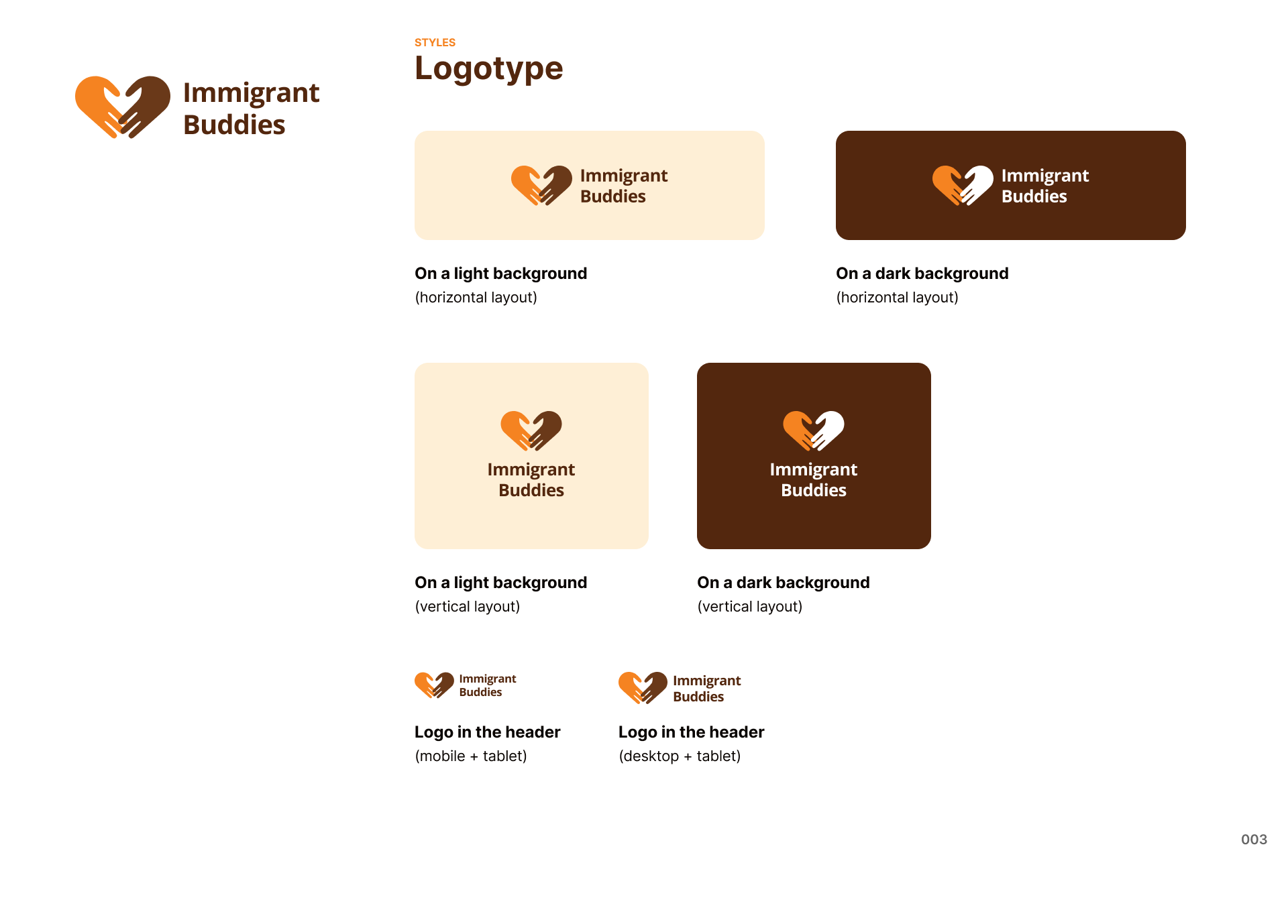
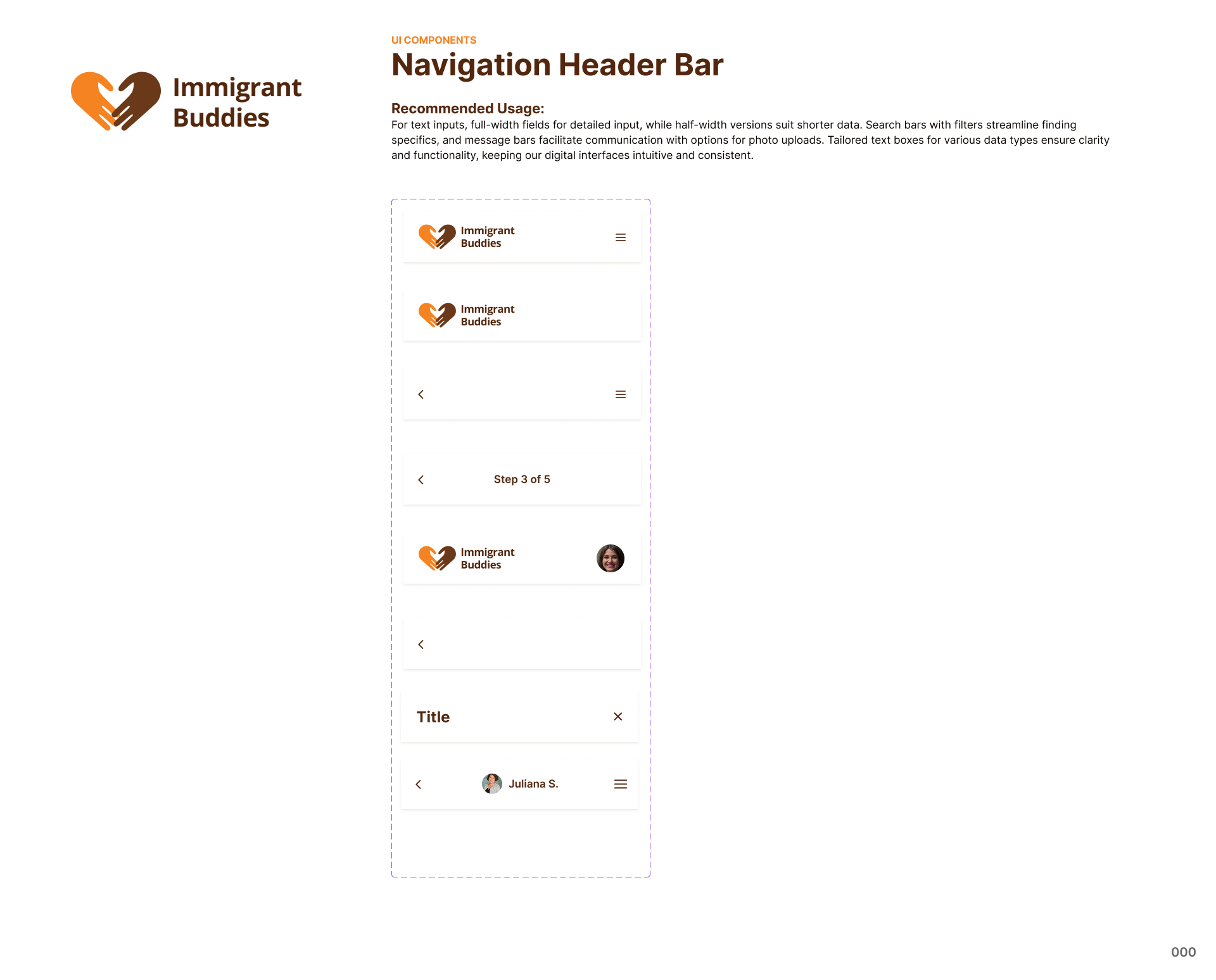
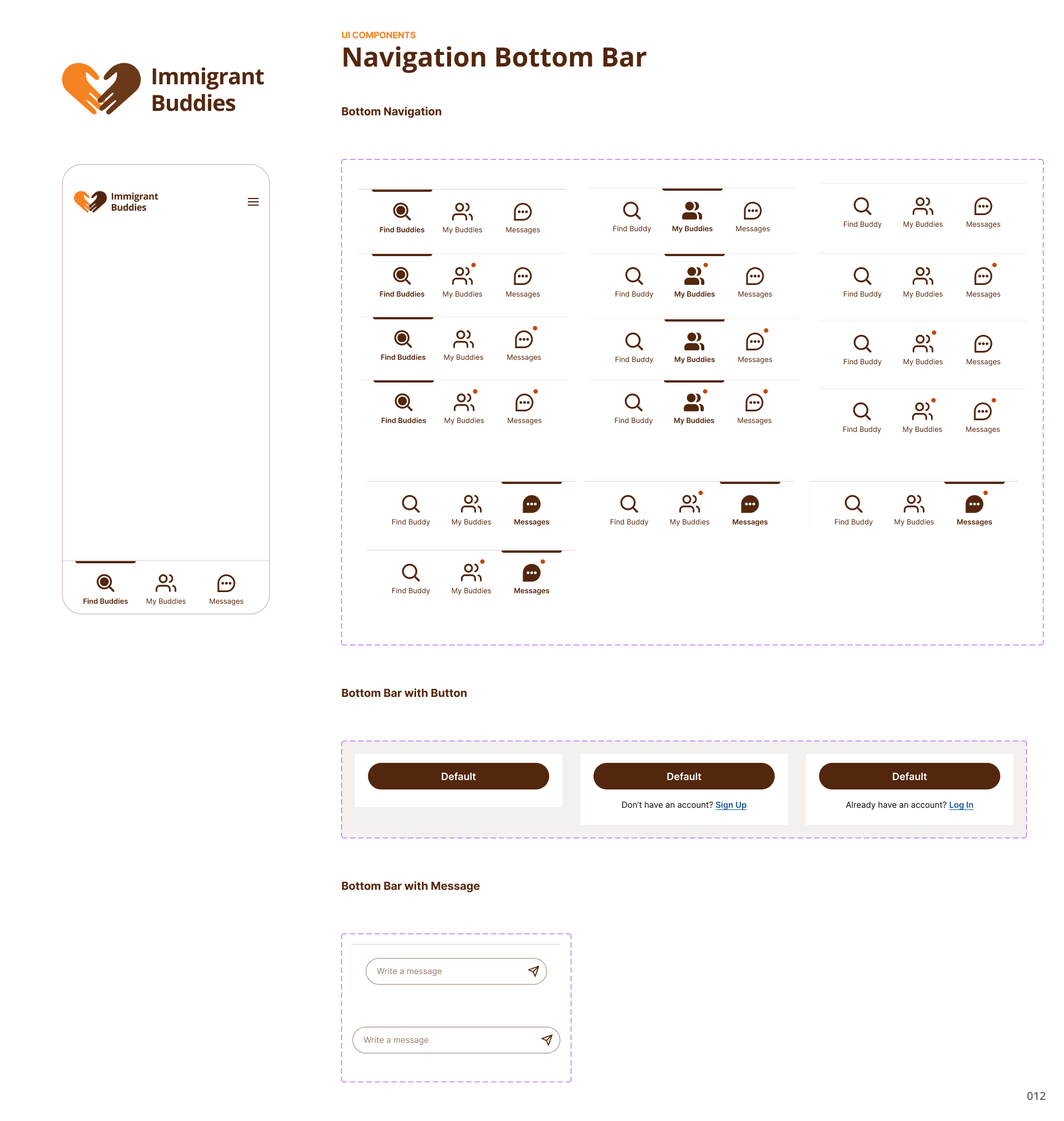
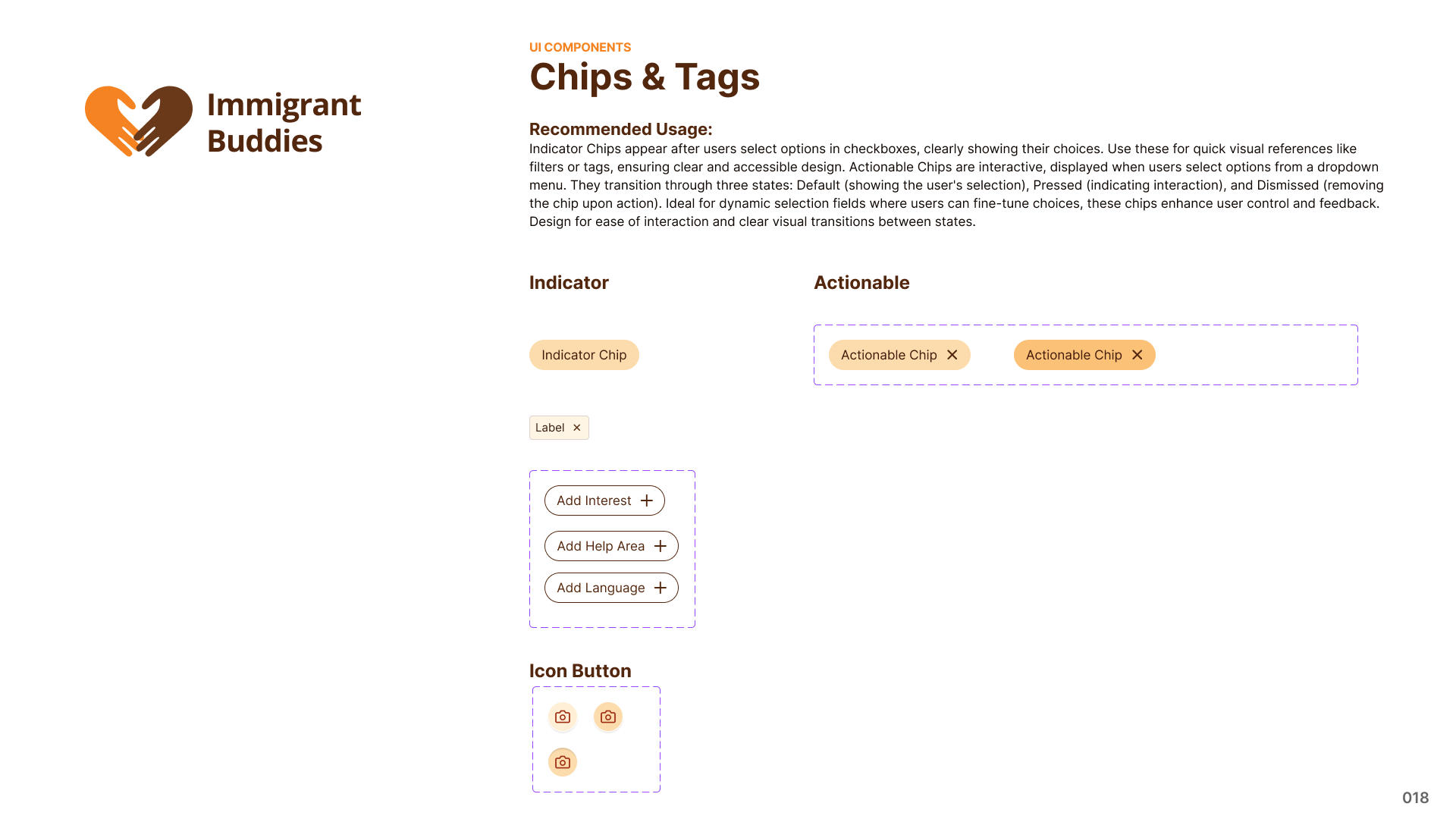
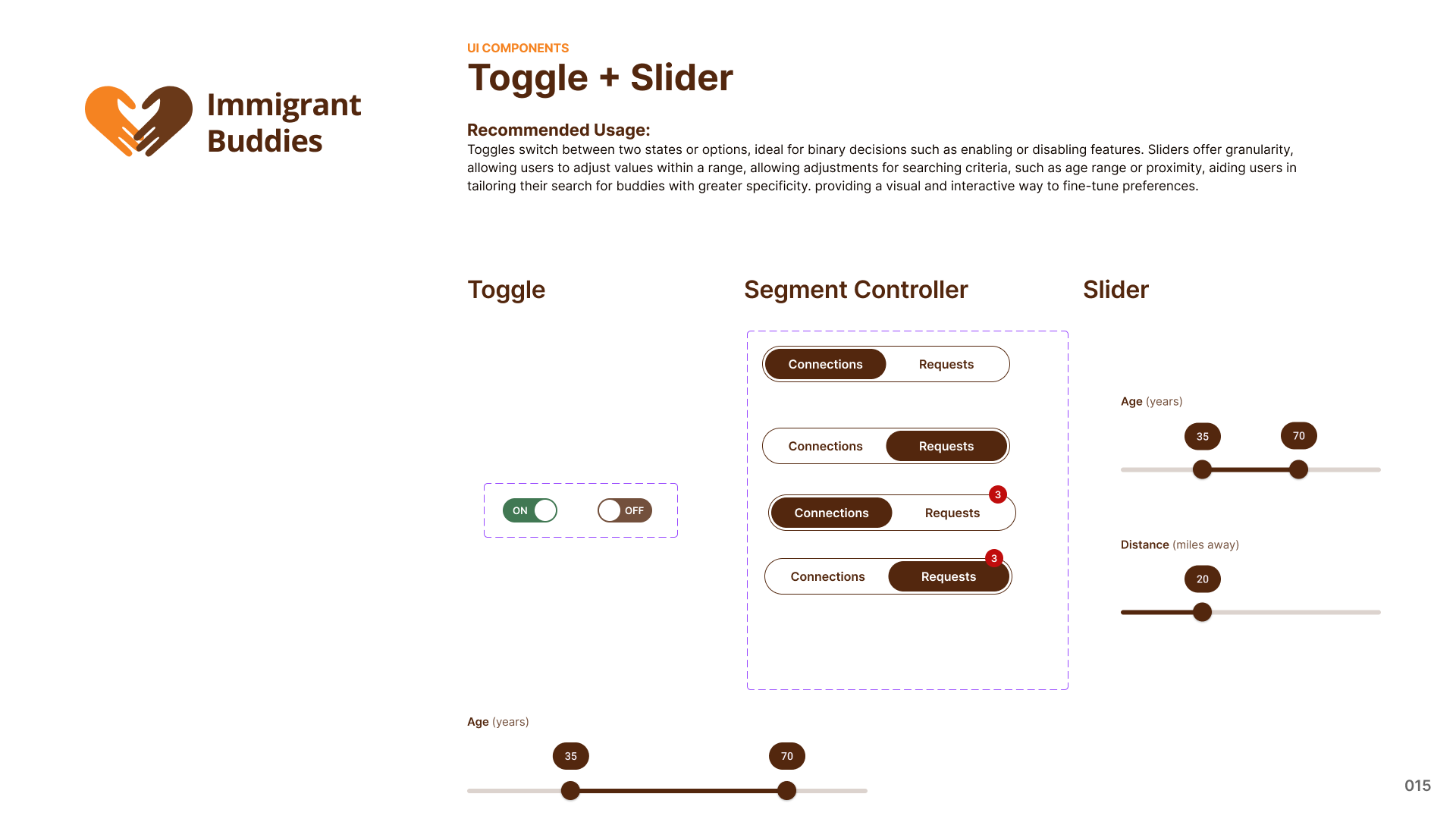
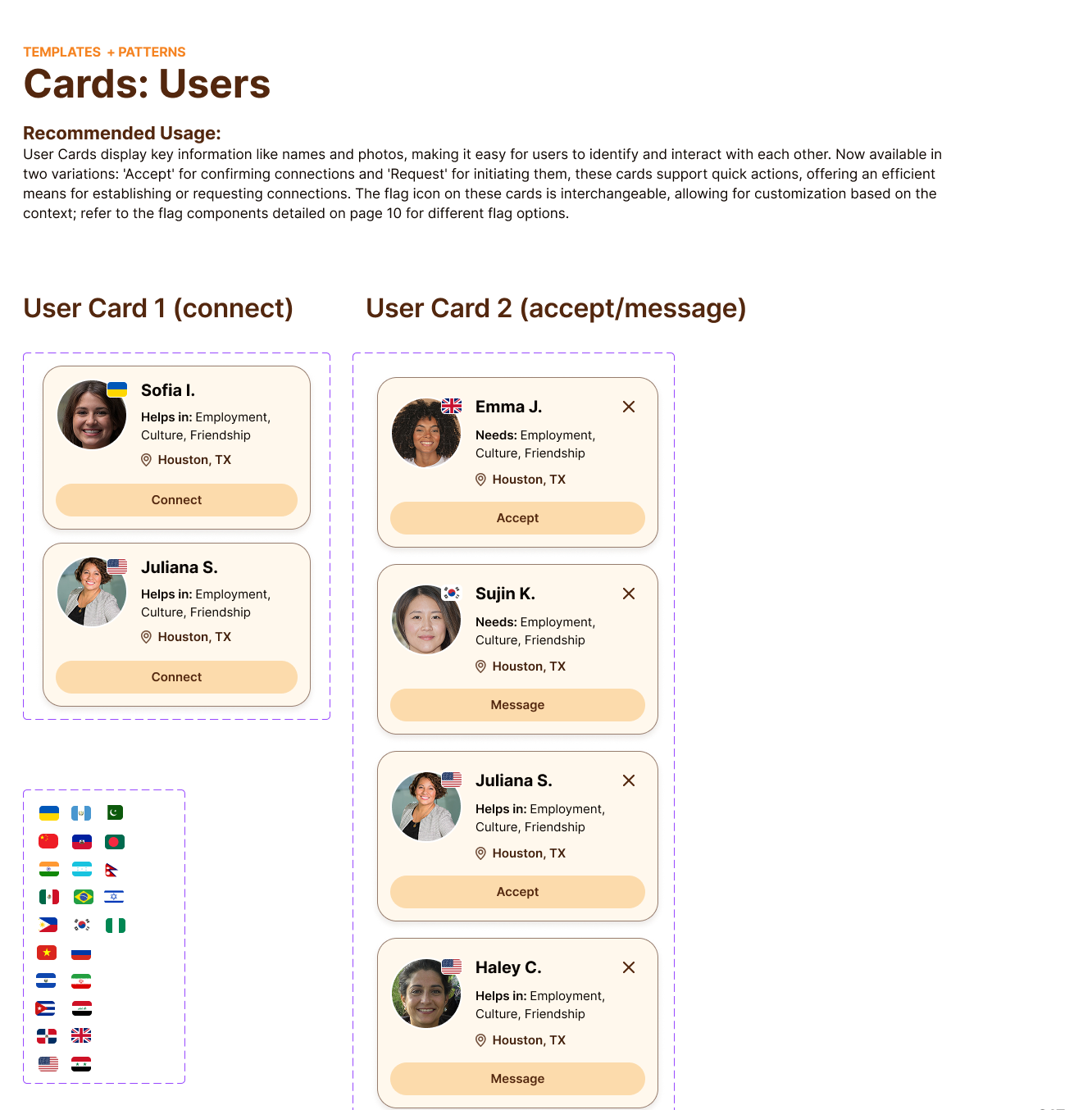

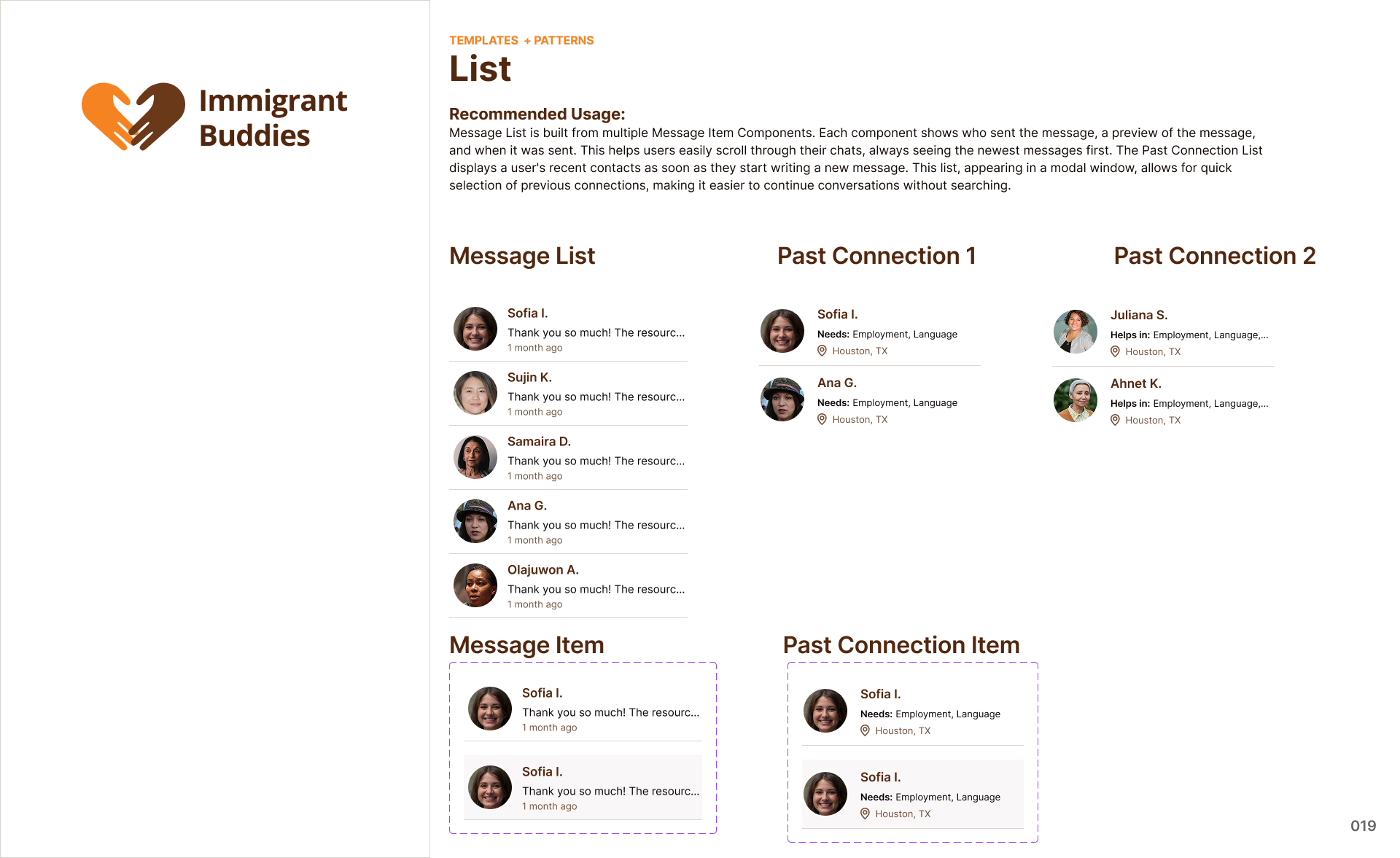
4. Deliver
We implemented our changes from the usability tests in our next high-fidelity mobile prototype, which utilized the elements of our mobile design system.
The team created high-fidelity wireframes using the components in the design system in Figma. I then added interactions to the wireframes to turn them into the clickable prototype below.
I asked my team to conduct a second round of usability tests (2 tests assigned per team member) on our V2 high-fidelity mobile prototype for immigrants and Buddies to identify additional gaps in usability.
For this round of tests, we had different participants than the first round go through the same Usability Test Plan for immigrants and Buddies and test scenarios via Google Forms for immigrants and Buddies.
We compiled the results of our usability tests through a Google Forms summary for immigrants and Buddies. Using a spreadsheet, I analyzed the test results, identified the most commonly mentioned issues and points of confusion, and determined what to change for our V3 high-fidelity mobile prototype.
As a team, we met to discuss the results of our respective tests. I noted all the issues and counted the ones that were noted most often by users. We implemented changes to the ones mentioned more than once, as well as a few other tweaks based on our judgment as a group. See the list of changes below (the issues mentioned more than once are in yellow).
We then implemented the changes in our final wireframes for a V3 high-fi mobile prototype. Then, we made design system components for the desktop view below. Afterwards, we made high-fidelity desktop wireframes and a high-fidelity desktop prototype. We then conducted usability tests on the desktop prototypes for 6 participants on the immigrant side.
For this round of tests, we had different participants than the first round go through the same test scenarios for immigrants with these summary results.
Overall, since we had tweaked a lot from the mobile tests, the desktop view had minimal changes needed. Some minor changes we made to the final version are: Adding "Find Activities" and "Find Communities" and "Find Food & Water" to the “Areas of Help”, Deleting "search by name" because we don't know the name of the Buddies, Changing the “Requests” tab to "Incoming Requests" on desktop and keeping "Requests" on Mobile, and making reviews on the Home Page more concise. We also noted suggestions for future features such as verified profiles/ background checks and Buddy recommendations.
After iterating with multiple rounds of usability tests, I determined that we were now ready to make final wireframes across all device sizes (mobile, desktop, and tablet) for development. I split up screens for the team to wireframe. Afterward, I made the final interactive prototypes below.
The prototypes above are what we gave development for illustrative purposes. The development and design teams then determined additional changes. Below are our final updated wireframes with design adjustments after hand-off to development.
The team adjusted our screens to be complete with auto-layout, revised dimensions, and additional needed features such as Email Verification and Forgot Password. Sample final screens for development are below.
Home Page before Login

Mobile
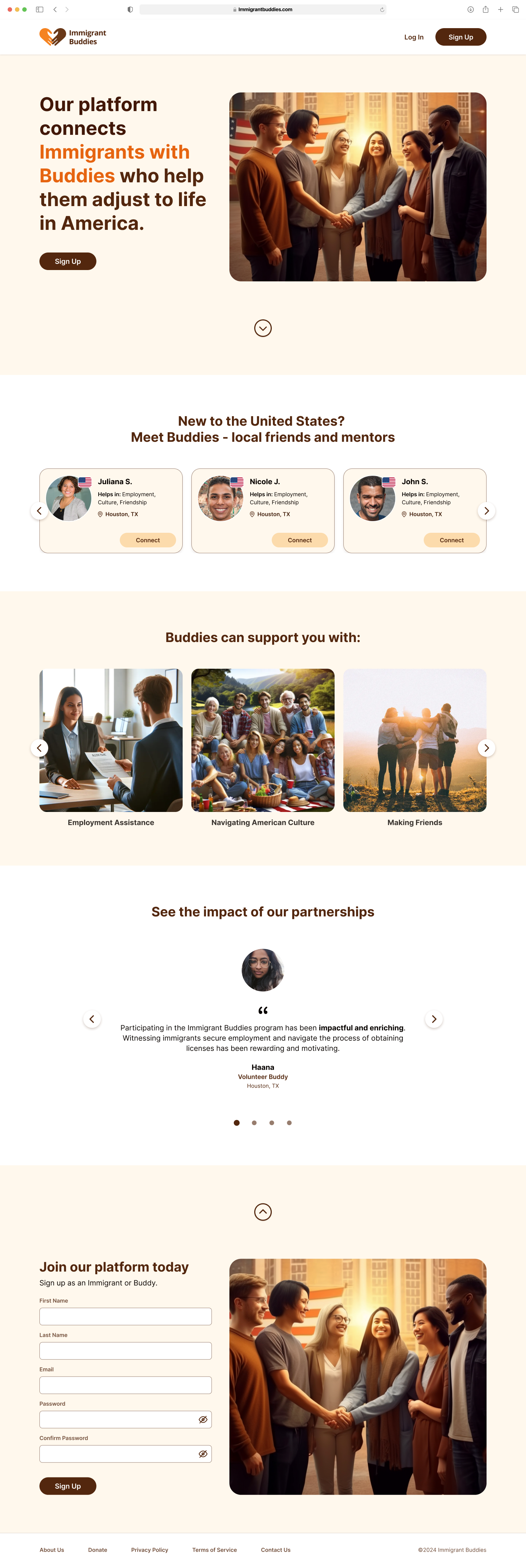
Desktop

Laptop

Tablet
Register: Create Profile

Mobile

Desktop

Laptop

Tablet
My Profile (Immigrant)

Mobile
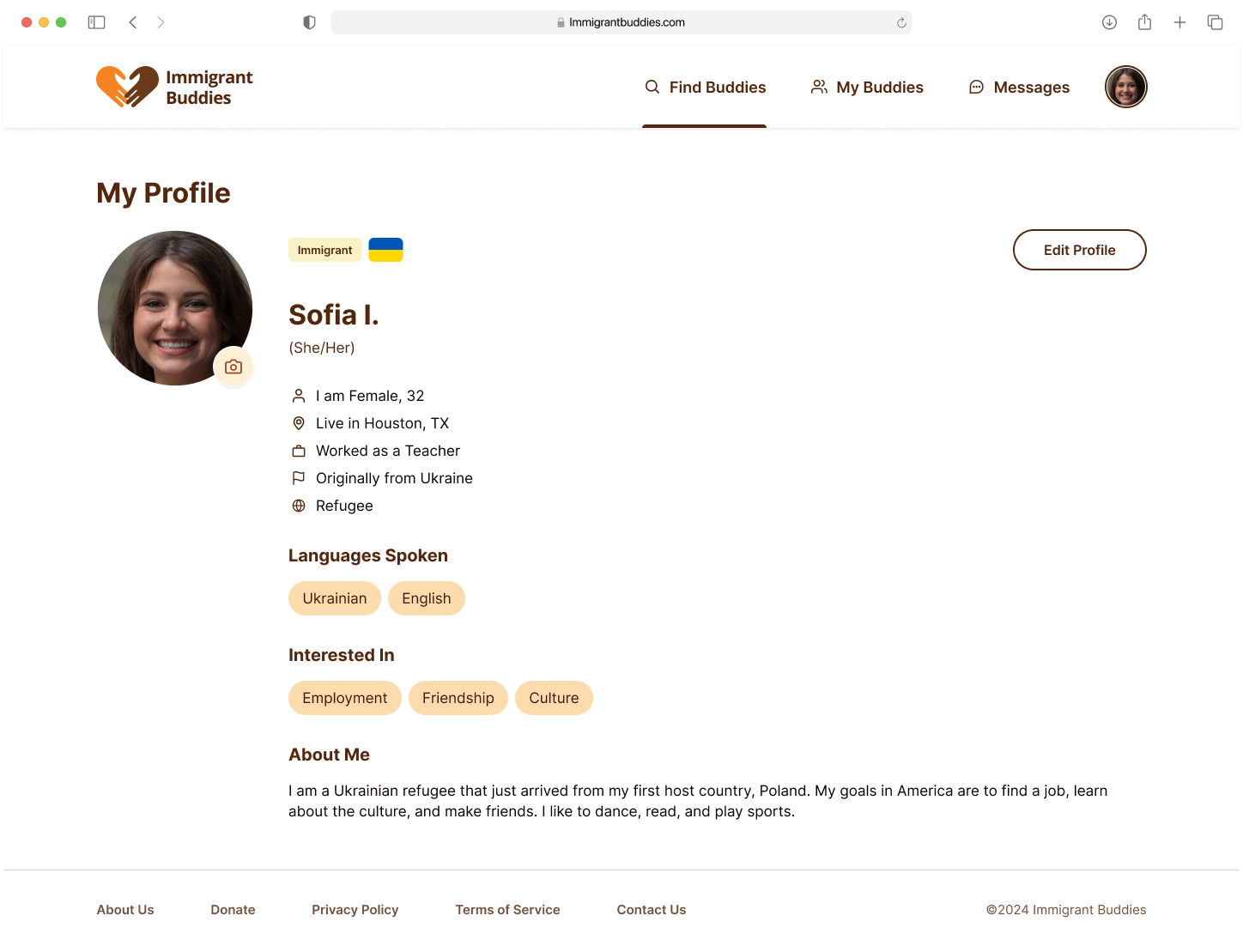
Desktop
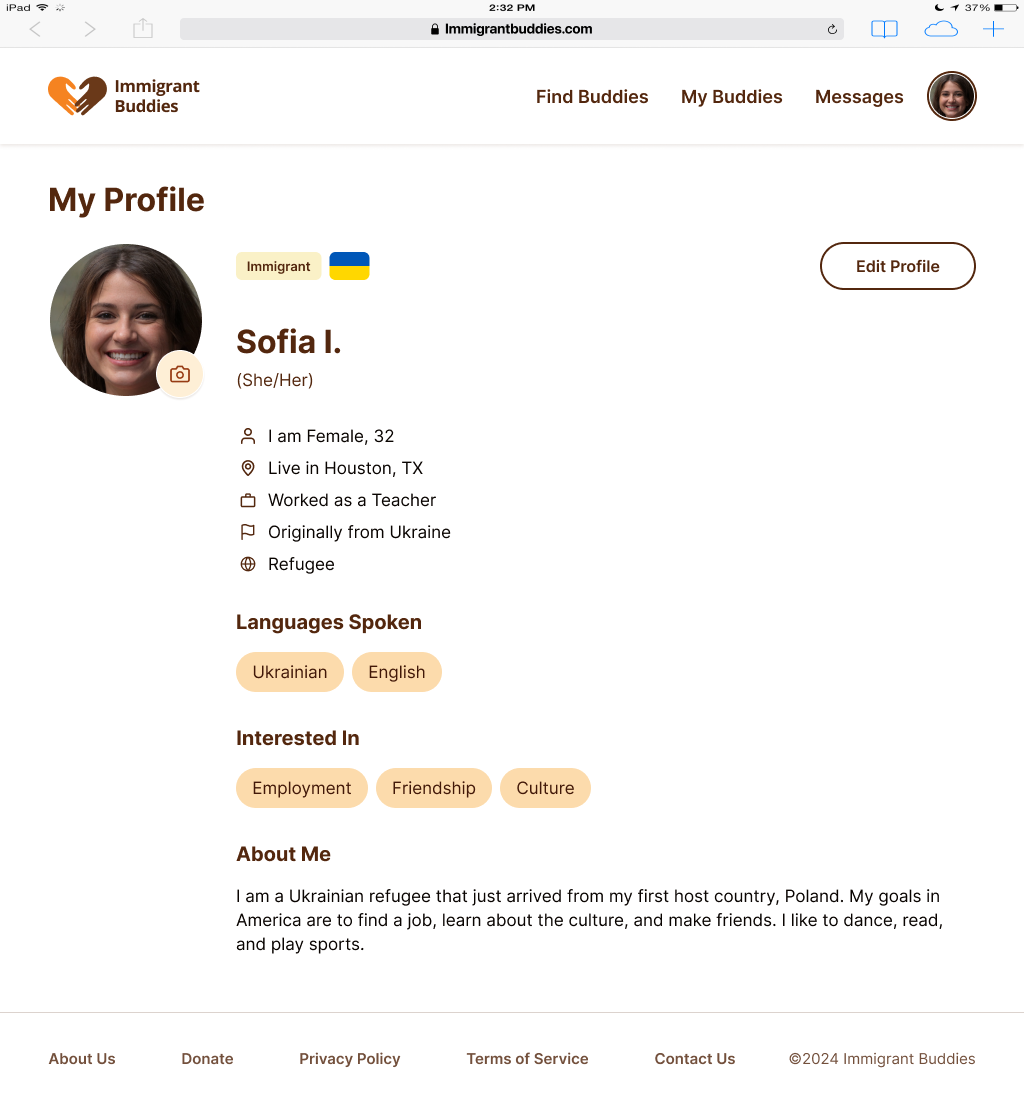
Laptop

Tablet
Find Buddies (Home Page after Login)

Mobile
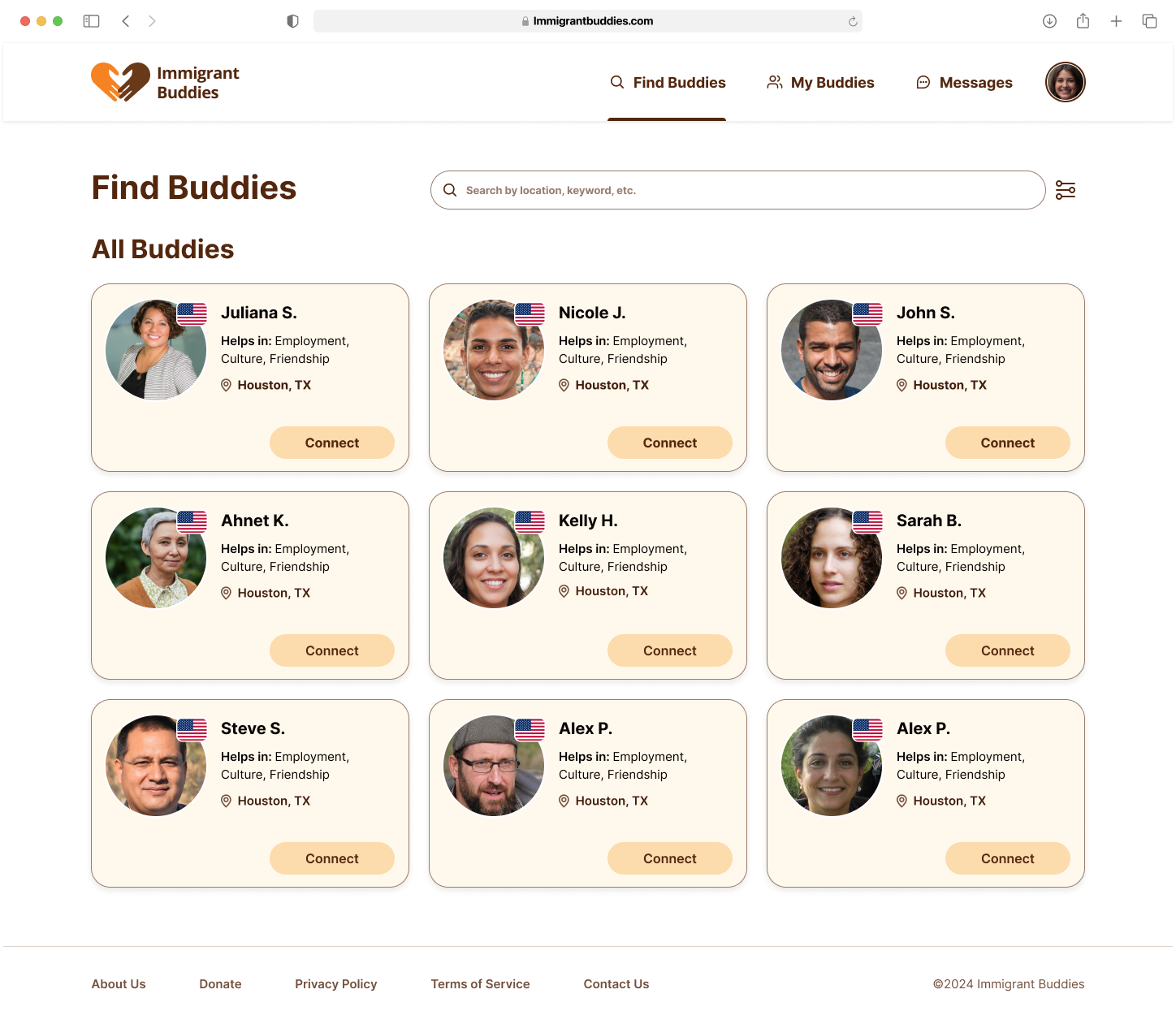
Desktop

Laptop
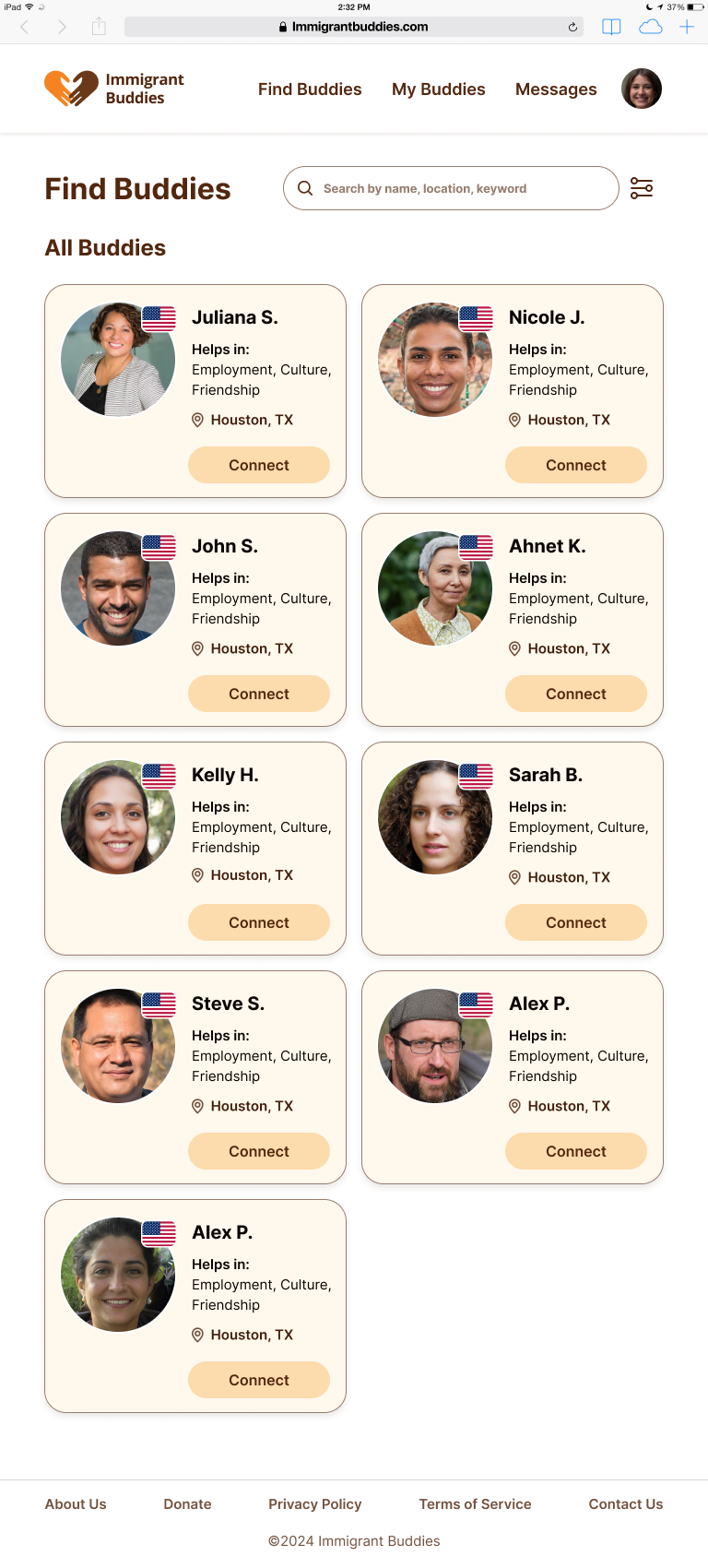
Tablet
Filters
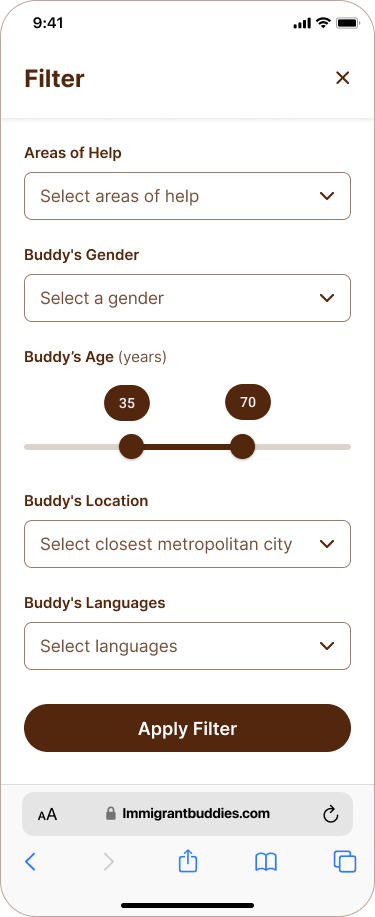
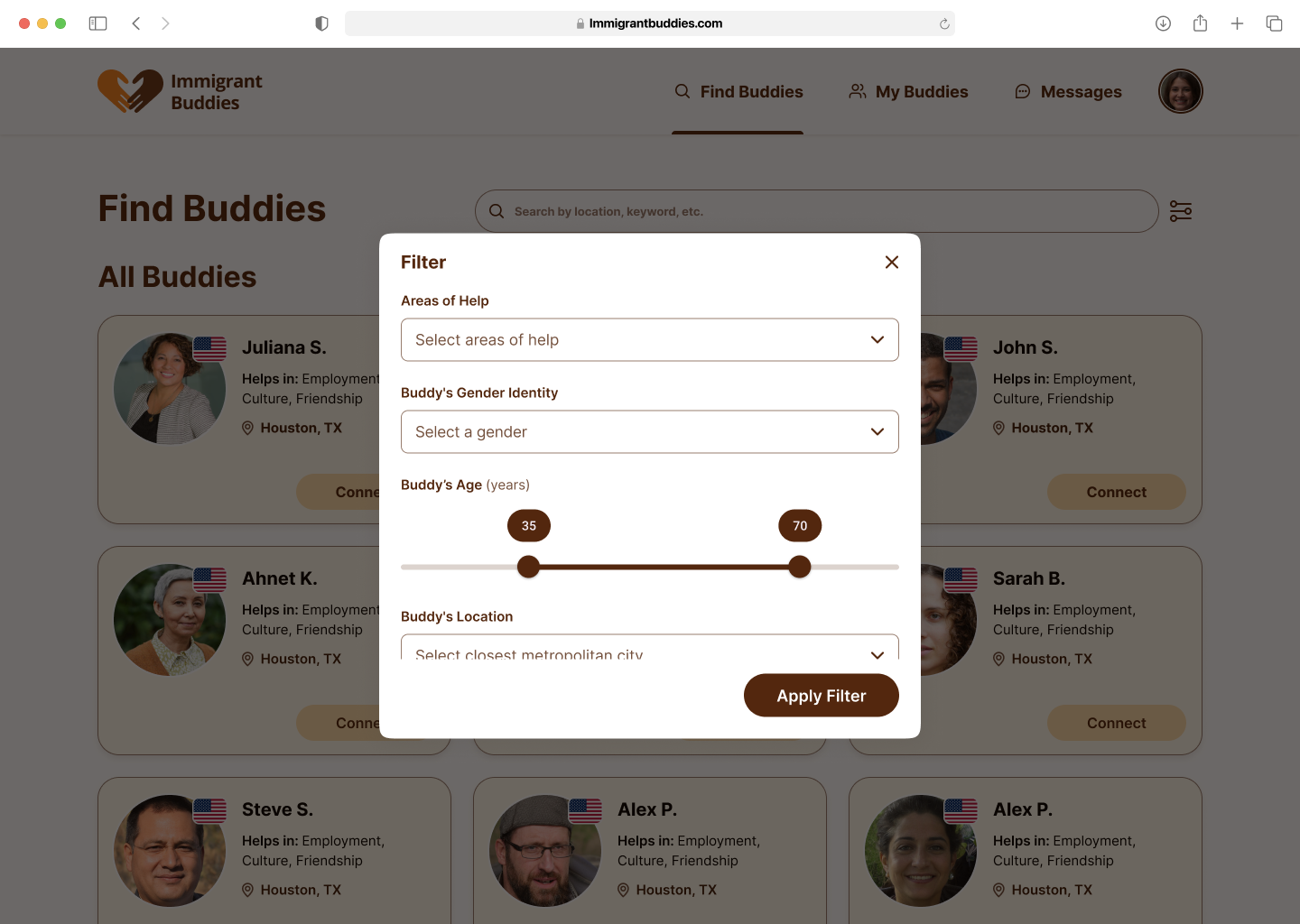

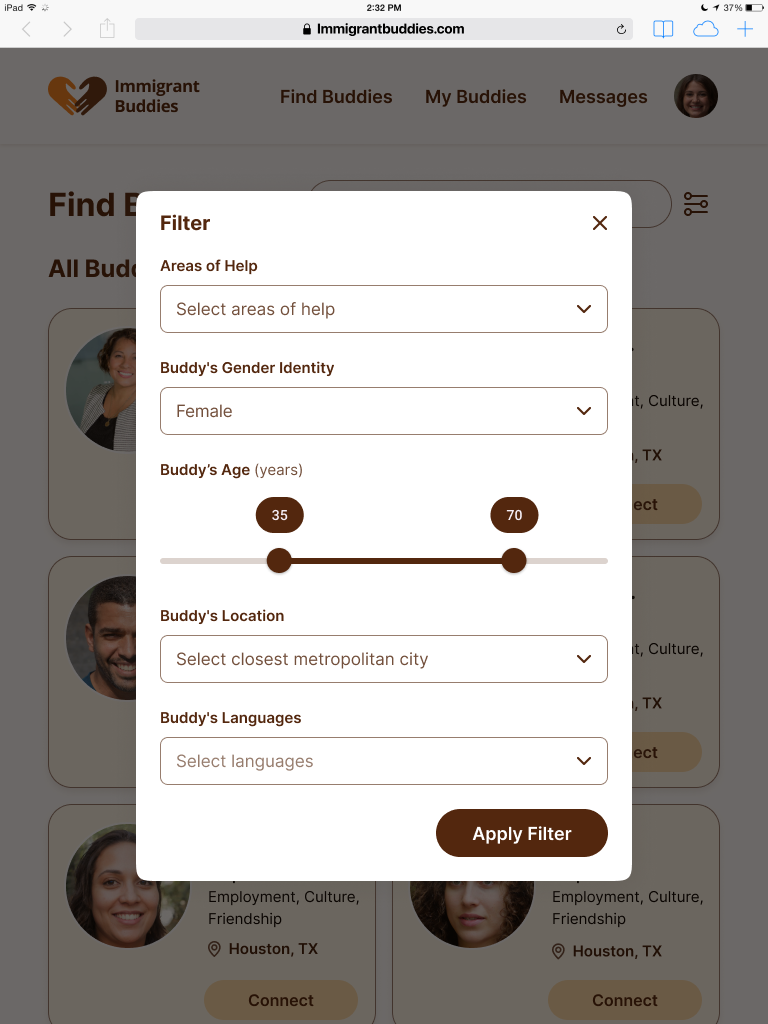
Buddy Profile

Mobile

Desktop
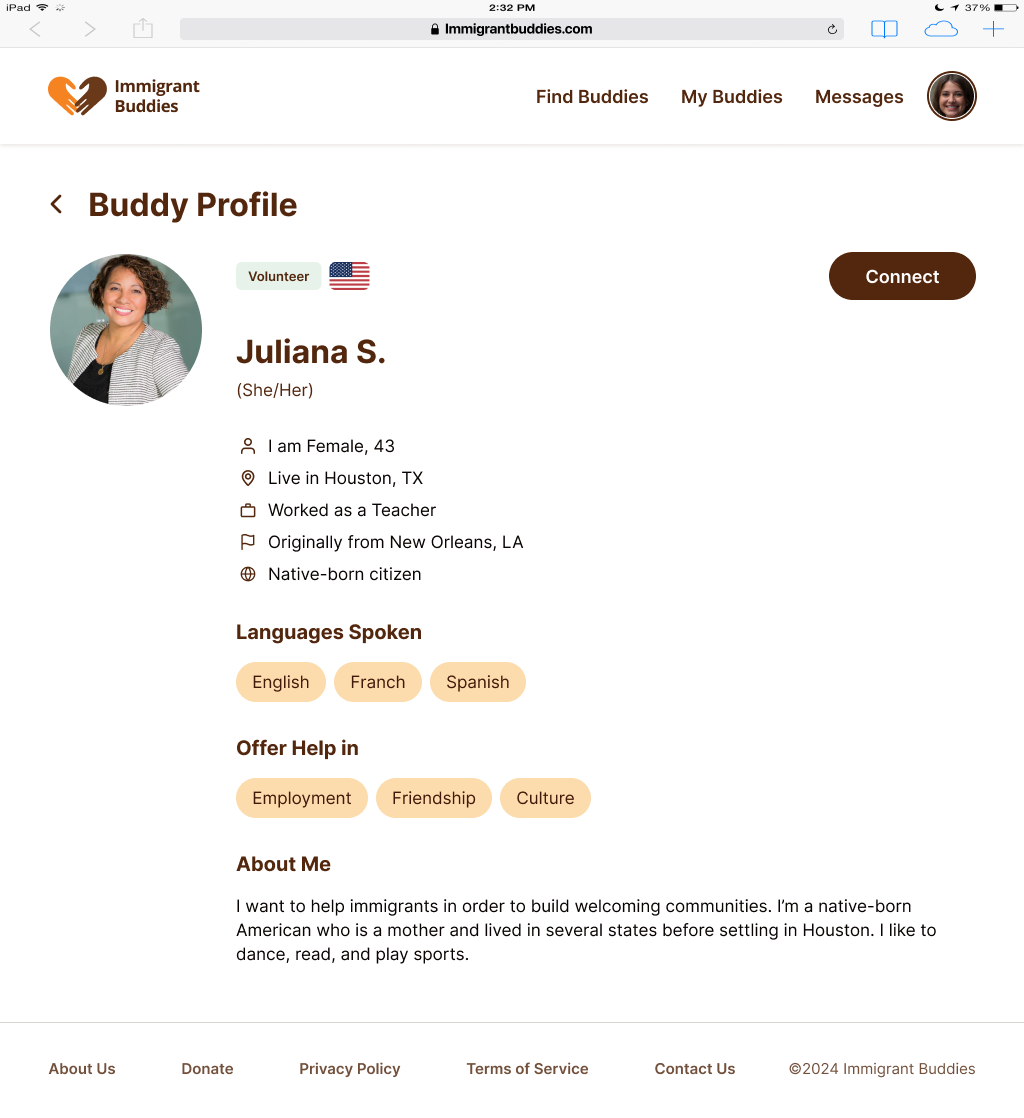
Laptop

Tablet
My Buddies - Connections

Mobile

Desktop

Laptop

Tablet
Messaging
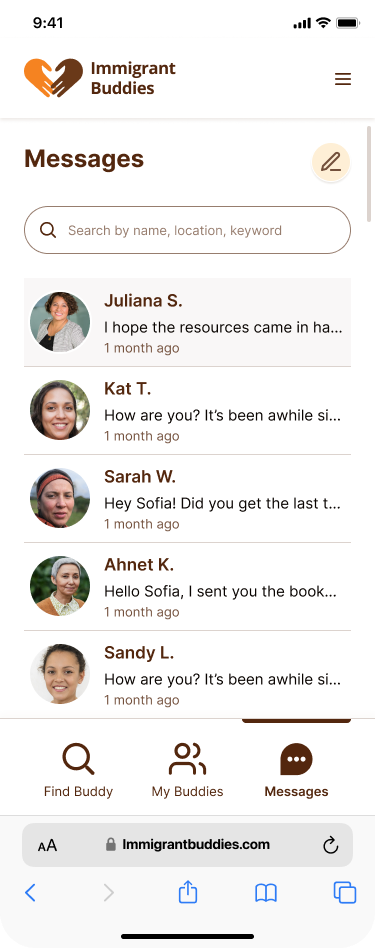
Mobile
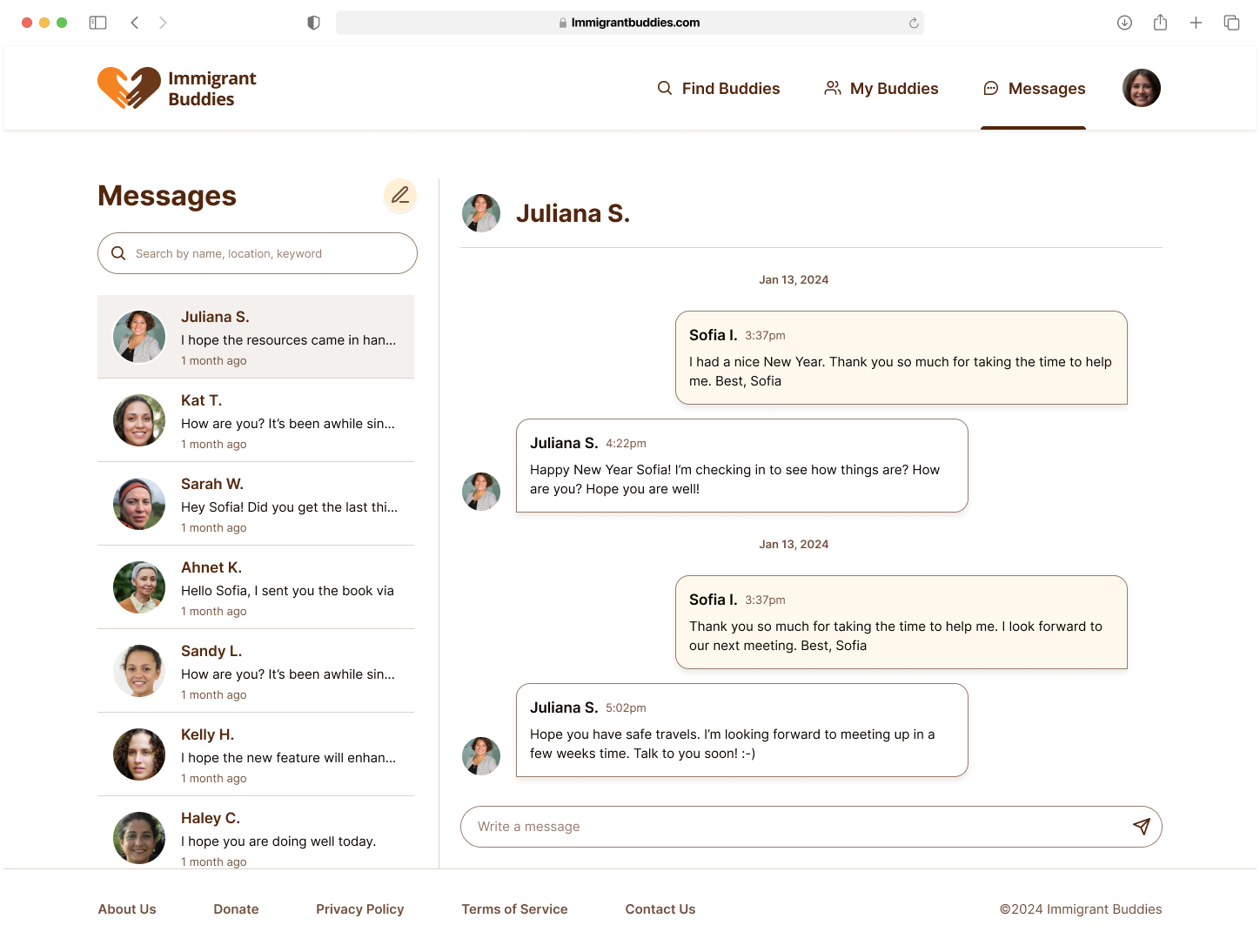
Desktop

Laptop

Tablet
Contact Us


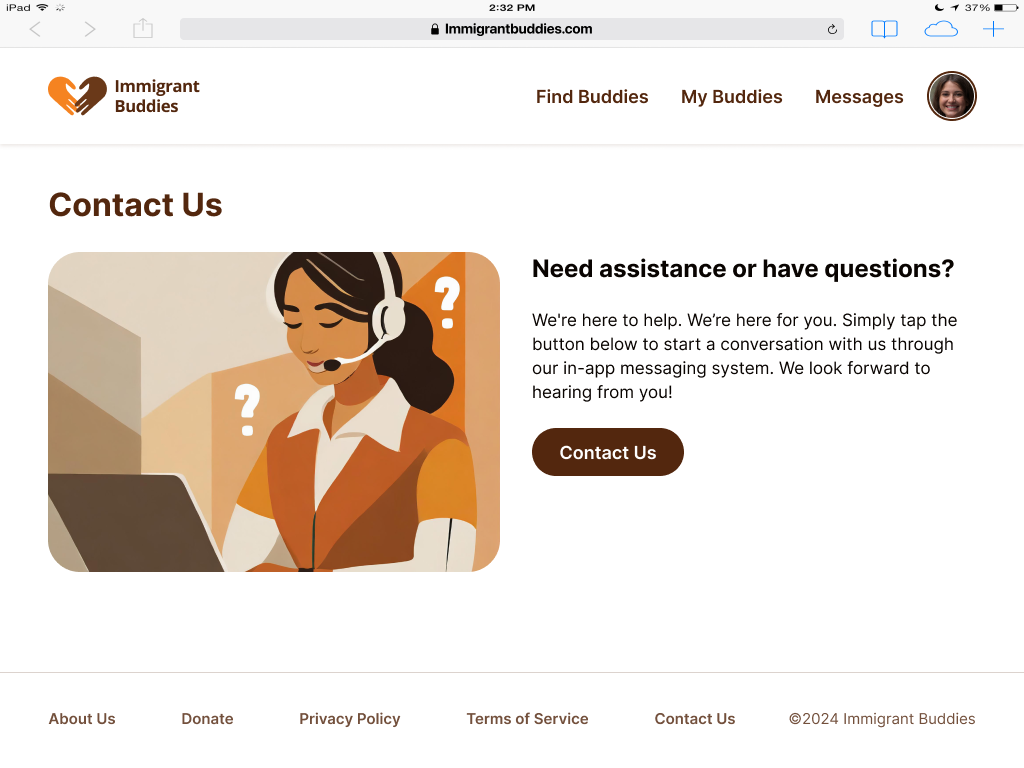

Based on some user feedback from our Concierge MVP and usability tests, I made a list of features and capabilities to include in our roadmap. I also placed some ideas in our icebox.
•Multi-language capability so that immigrants can view the product in their native language
•Verification process or background check to ensure the identities and legitimacy of immigrants and Buddies
•Resources section so that immigrants can view a common list of resources in their integration process, and Buddies can reference these resources to assist immigrants (sections would include resources for each Area of Help, such as Immigrant Services organizations, VISA-friendly job sites, employment services, apartment listings and temporary stays, healthcare providers, information on driver’s licenses, bus routes, and ride-shares, lawyers, daycare centers, English language tutoring
•Other ideas: Reviews of Buddies, Recommended Buddies


